Texas instruments TMS320F28332, TMS320F28232, TMS320F28235, TMS320F28234, TMS320F28334 Data Manual
...
TMS320F28335, TMS320F28334, TMS320F28332 TMS320F28235, TMS320F28234, TMS320F28232
Digital Signal Controllers (DSCs)
Data Manual
PRODUCTION DATA information is current as of publication date. Products conform to specifications per the terms of the Texas Instruments standard warranty. Production processing does not necessarily include testing of all parameters.
Literature Number: SPRS439I
June 2007 –Revised March 2011

TMS320F28335, TMS320F28334, TMS320F28332
TMS320F28235, TMS320F28234, TMS320F28232
SPRS439I–JUNE 2007 –REVISED MARCH 2011 www.ti.com
|
|
|
Contents |
|
1 |
TMS320F2833x, TMS320F2823x DSCs .................................................................................. |
11 |
||
|
1.1 |
Features |
.................................................................................................................... |
11 |
|
1.2 |
Getting Started ............................................................................................................. |
12 |
|
2 |
Introduction ...................................................................................................................... |
|
13 |
|
|
2.1 |
Pin Assignments ........................................................................................................... |
15 |
|
|
2.2 |
Signal Descriptions ........................................................................................................ |
24 |
|
3 |
Functional Overview .......................................................................................................... |
34 |
||
|
3.1 |
Memory Maps .............................................................................................................. |
35 |
|
|
3.2 |
Brief Descriptions .......................................................................................................... |
42 |
|
|
|
3.2.1 |
C28x CPU ....................................................................................................... |
42 |
|
|
3.2.2 |
Memory Bus (Harvard Bus Architecture) .................................................................... |
42 |
|
|
3.2.3 |
Peripheral Bus .................................................................................................. |
42 |
|
|
3.2.4 |
Real-Time JTAG and Analysis ................................................................................ |
43 |
|
|
3.2.5 |
External Interface (XINTF) .................................................................................... |
43 |
|
|
3.2.6 |
Flash ............................................................................................................. |
43 |
|
|
3.2.7 |
M0, M1 SARAMs ............................................................................................... |
43 |
|
|
3.2.8 |
L0, L1, L2, L3, L4, L5, L6, L7 SARAMs ..................................................................... |
44 |
|
|
3.2.9 |
Boot ROM ........................................................................................................ |
44 |
|
|
|
3.2.9.1 Peripheral Pins Used by the Bootloader ........................................................ |
45 |
|
|
3.2.10 |
Security .......................................................................................................... |
45 |
|
|
3.2.11 |
Peripheral Interrupt Expansion (PIE) Block ................................................................. |
47 |
|
|
3.2.12 |
External Interrupts (XINT1–XINT7, XNMI) .................................................................. |
47 |
|
|
3.2.13 |
Oscillator and PLL .............................................................................................. |
47 |
|
|
3.2.14 |
Watchdog ........................................................................................................ |
47 |
|
|
3.2.15 |
Peripheral Clocking ............................................................................................. |
47 |
|
|
3.2.16 |
Low-Power Modes .............................................................................................. |
47 |
|
|
3.2.17 |
Peripheral Frames 0, 1, 2, 3 (PFn) ........................................................................... |
48 |
|
|
3.2.18 |
General-Purpose Input/Output (GPIO) Multiplexer ......................................................... |
48 |
|
|
3.2.19 |
32-Bit CPU-Timers (0, 1, 2) ................................................................................... |
48 |
|
|
3.2.20 |
Control Peripherals ............................................................................................. |
49 |
|
|
3.2.21 |
Serial Port Peripherals ......................................................................................... |
49 |
|
3.3 |
Register Map ............................................................................................................... |
50 |
|
|
3.4 |
Device Emulation Registers .............................................................................................. |
52 |
|
|
3.5 |
Interrupts .................................................................................................................... |
53 |
|
|
|
3.5.1 |
External Interrupts .............................................................................................. |
57 |
|
3.6 |
System Control ............................................................................................................ |
58 |
|
|
|
3.6.1 |
OSC and PLL Block ............................................................................................ |
59 |
|
|
|
3.6.1.1 External Reference Oscillator Clock Option .................................................... |
60 |
|
|
|
3.6.1.2 PLL-Based Clock Module ......................................................................... |
61 |
|
|
|
3.6.1.3 Loss of Input Clock ................................................................................ |
62 |
|
|
3.6.2 |
Watchdog Block ................................................................................................. |
63 |
|
3.7 |
Low-Power Modes Block ................................................................................................. |
64 |
|
4 |
Peripherals ....................................................................................................................... |
|
65 |
|
|
4.1 |
DMA Overview ............................................................................................................. |
65 |
|
|
4.2 |
32-Bit CPU-Timers 0/1/2 ................................................................................................. |
67 |
|
2 |
Contents |
Copyright © 2007–2011, Texas Instruments Incorporated |

|
|
|
TMS320F28335, TMS320F28334, TMS320F28332 |
||
|
|
|
TMS320F28235, TMS320F28234, TMS320F28232 |
||
www.ti.com |
|
|
SPRS439I –JUNE 2007 –REVISED MARCH 2011 |
||
|
4.3 |
Enhanced PWM Modules (ePWM1/2/3/4/5/6 ) ........................................................................ |
|
69 |
|
|
4.4 |
High-Resolution PWM (HRPWM) ....................................................................................... |
|
73 |
|
|
4.5 |
Enhanced CAP Modules (eCAP1/2/3/4/5/6) ........................................................................... |
|
74 |
|
|
4.6 |
Enhanced QEP Modules (eQEP1/2 ) ................................................................................... |
|
76 |
|
|
4.7 |
Analog-to-Digital Converter (ADC) Module ............................................................................ |
|
78 |
|
|
|
4.7.1 |
ADC Connections if the ADC Is Not Used .................................................................. |
|
82 |
|
|
4.7.2 |
ADC Registers .................................................................................................. |
|
83 |
|
|
4.7.3 |
ADC Calibration ................................................................................................. |
|
84 |
|
4.8 |
Multichannel Buffered Serial Port (McBSP) Module .................................................................. |
|
84 |
|
|
4.9 |
Enhanced Controller Area Network (eCAN) Modules (eCAN-A and eCAN-B) |
.................................... 87 |
||
|
4.10 |
Serial Communications Interface (SCI) Modules (SCI-A, SCI-B, SCI-C) .......................................... |
|
92 |
|
|
4.11 |
Serial Peripheral Interface (SPI) Module (SPI-A ) ..................................................................... |
|
96 |
|
|
4.12 |
Inter-Integrated Circuit (I2C) ............................................................................................. |
|
99 |
|
|
4.13 |
GPIO MUX ................................................................................................................ |
|
100 |
|
|
4.14 |
External Interface (XINTF) .............................................................................................. |
|
107 |
|
5 |
Device Support ................................................................................................................ |
|
109 |
||
|
5.1 |
Device and Development Support Tool Nomenclature ............................................................. |
|
109 |
|
|
5.2 |
Documentation Support ................................................................................................. |
|
111 |
|
|
5.3 |
Community Resources .................................................................................................. |
|
116 |
|
6 |
Electrical Specifications ................................................................................................... |
|
117 |
||
|
6.1 |
Absolute Maximum Ratings ............................................................................................. |
|
117 |
|
|
6.2 |
Recommended Operating Conditions ................................................................................. |
|
118 |
|
|
6.3 |
Electrical Characteristics ................................................................................................ |
|
118 |
|
|
6.4 |
Current Consumption .................................................................................................... |
|
119 |
|
|
|
6.4.1 |
Reducing Current Consumption ............................................................................. |
|
121 |
|
|
6.4.2 |
Current Consumption Graphs ............................................................................... |
|
122 |
|
|
6.4.3 |
Thermal Design Considerations ............................................................................. |
|
123 |
|
6.5 |
Emulator Connection Without Signal Buffering for the DSP ....................................................... |
|
124 |
|
|
6.6 |
Timing Parameter Symbology .......................................................................................... |
|
125 |
|
|
|
6.6.1 |
General Notes on Timing Parameters ...................................................................... |
|
125 |
|
|
6.6.2 |
Test Load Circuit .............................................................................................. |
|
125 |
|
|
6.6.3 |
Device Clock Table ........................................................................................... |
|
126 |
|
6.7 |
Clock Requirements and Characteristics ............................................................................. |
|
127 |
|
|
6.8 |
Power Sequencing ....................................................................................................... |
|
128 |
|
|
|
6.8.1 |
Power Management and Supervisory Circuit Solutions .................................................. |
|
128 |
|
6.9 |
General-Purpose Input/Output (GPIO) ................................................................................ |
|
131 |
|
|
|
6.9.1 |
GPIO - Output Timing ........................................................................................ |
|
131 |
|
|
6.9.2 |
GPIO - Input Timing .......................................................................................... |
|
132 |
|
|
6.9.3 |
Sampling Window Width for Input Signals ................................................................. |
|
133 |
|
|
6.9.4 |
Low-Power Mode Wakeup Timing .......................................................................... |
|
134 |
|
6.10 |
Enhanced Control Peripherals ......................................................................................... |
|
139 |
|
|
|
6.10.1 |
Enhanced Pulse Width Modulator (ePWM) Timing ....................................................... |
|
139 |
|
|
6.10.2 |
Trip-Zone Input Timing ....................................................................................... |
|
139 |
|
|
6.10.3 |
Enhanced Capture (eCAP) Timing ......................................................................... |
|
140 |
|
|
6.10.4 |
Enhanced Quadrature Encoder Pulse (eQEP) Timing ................................................... |
|
140 |
|
|
6.10.5 |
ADC Start-of-Conversion Timing ............................................................................ |
|
141 |
|
6.11 |
External Interrupt Timing ................................................................................................ |
|
141 |
|
Copyright © 2007–2011, Texas Instruments Incorporated |
Contents |
3 |

TMS320F28335, TMS320F28334, TMS320F28332
TMS320F28235, TMS320F28234, TMS320F28232
SPRS439I–JUNE 2007 –REVISED MARCH 2011 |
www.ti.com |
||||||
|
6.12 |
I2C Electrical Specification and Timing ............................................................................... |
142 |
||||
|
6.13 |
Serial Peripheral Interface (SPI) Timing .............................................................................. |
142 |
||||
|
|
6.13.1 |
Master Mode Timing .......................................................................................... |
142 |
|||
|
|
6.13.2 SPI Slave Mode Timing ...................................................................................... |
147 |
||||
|
6.14 |
External Interface (XINTF) Timing ..................................................................................... |
150 |
||||
|
|
6.14.1 |
USEREADY = 0 ............................................................................................... |
150 |
|||
|
|
6.14.2 Synchronous Mode (USEREADY = 1, READYMODE = 0) ............................................. |
151 |
||||
|
|
6.14.3 Asynchronous Mode (USEREADY = 1, READYMODE = 1) ............................................ |
152 |
||||
|
|
6.14.4 XINTF Signal Alignment to XCLKOUT ..................................................................... |
154 |
||||
|
|
6.14.5 External Interface Read Timing ............................................................................. |
155 |
||||
|
|
6.14.6 External Interface Write Timing ............................................................................. |
157 |
||||
|
|
6.14.7 External Interface Ready-on-Read Timing With One External Wait State ............................ |
159 |
||||
|
|
6.14.8 External Interface Ready-on-Write Timing With One External Wait State ............................. |
162 |
||||
|
|
6.14.9 |
|
and |
|
Timing |
165 |
|
|
XHOLD |
XHOLDA |
||||
|
6.15 |
On-Chip Analog-to-Digital Converter .................................................................................. |
168 |
||||
|
|
6.15.1 ADC Power-Up Control Bit Timing .......................................................................... |
169 |
||||
|
|
6.15.2 |
Definitions ...................................................................................................... |
170 |
|||
|
|
6.15.3 Sequential Sampling Mode (Single-Channel) (SMODE = 0) ............................................ |
171 |
||||
|
|
6.15.4 Simultaneous Sampling Mode (Dual-Channel) (SMODE = 1) .......................................... |
172 |
||||
|
|
6.15.5 |
Detailed Descriptions ......................................................................................... |
173 |
|||
|
6.16 |
Multichannel Buffered Serial Port (McBSP) Timing ................................................................. |
174 |
||||
|
|
6.16.1 McBSP Transmit and Receive Timing ...................................................................... |
174 |
||||
|
|
6.16.2 McBSP as SPI Master or Slave Timing .................................................................... |
177 |
||||
|
6.17 |
Flash Timing .............................................................................................................. |
181 |
||||
|
6.18 |
Migrating Between F2833x Devices and F2823x Devices ......................................................... |
182 |
||||
7 |
Revision History .............................................................................................................. |
183 |
|||||
8 |
Thermal/Mechanical Data .................................................................................................. |
184 |
|||||
4 |
Contents |
Copyright © 2007–2011, Texas Instruments Incorporated |

TMS320F28335, TMS320F28334, TMS320F28332
TMS320F28235, TMS320F28234, TMS320F28232
www.ti.com SPRS439I –JUNE 2007 –REVISED MARCH 2011
List of Figures
2-1 |
F2833x, F2823x 176-Pin PGF/PTP LQFP (Top View) ...................................................................... |
15 |
|
2-2 |
F2833x, F2823x 179-Ball ZHH MicroStar BGA™ |
(Upper Left Quadrant) (Bottom View) .............................. |
17 |
2-3 |
F2833x, F2823x 179-Ball ZHH MicroStar BGA™ |
(Upper Right Quadrant) (Bottom View)............................. |
18 |
2-4 |
F2833x, F2823x 179-Ball ZHH MicroStar BGA™ |
(Lower Left Quadrant) (Bottom View) .............................. |
19 |
2-5 |
F2833x, F2823x 179-Ball ZHH MicroStar BGA ™ (Lower Right Quadrant) (Bottom View)............................. |
20 |
|
2-6 |
F2833x, F2823x 176-Ball ZJZ Plastic BGA (Upper Left Quadrant) (Bottom View)...................................... |
21 |
|
2-7 |
F2833x, F2823x 176-Ball ZJZ Plastic BGA (Upper Right Quadrant) (Bottom View) .................................... |
22 |
|
2-8 |
F2833x, F2823x 176-Ball ZJZ Plastic BGA (Lower Left Quadrant) (Bottom View)...................................... |
23 |
|
2-9 |
F2833x, F2823x 176-Ball ZJZ Plastic BGA (Lower Right Quadrant) (Bottom View) .................................... |
23 |
|
3-1 |
Functional Block Diagram ...................................................................................................... |
|
35 |
3-2 |
F28335/F28235 Memory Map ................................................................................................. |
|
37 |
3-3 |
F28334/F28234 Memory Map ................................................................................................. |
|
38 |
3-4 |
F28332/F28232 Memory Map ................................................................................................. |
|
38 |
3-5 |
External and PIE Interrupt Sources ............................................................................................ |
|
54 |
3-6 |
External Interrupts................................................................................................................ |
|
54 |
3-7 |
Multiplexing of Interrupts Using the PIE Block ............................................................................... |
|
55 |
3-8 |
Clock and Reset Domains ...................................................................................................... |
|
58 |
3-9 |
OSC and PLL Block Diagram................................................................................................... |
|
59 |
3-10 |
Using a 3.3-V External Oscillator............................................................................................... |
|
60 |
3-11 |
Using a 1.9 -V External Oscillator.............................................................................................. |
|
60 |
3-12 |
Using the Internal Oscillator .................................................................................................... |
|
60 |
3-13 |
Watchdog Module ................................................................................................................ |
|
63 |
4-1 |
DMA Functional Block Diagram ................................................................................................ |
|
66 |
4-2 |
CPU-Timers ....................................................................................................................... |
|
67 |
4-3 |
CPU-Timer Interrupt Signals and Output Signal ............................................................................. |
|
67 |
4-4 |
Multiple PWM Modules in an 2833x/2823x System ......................................................................... |
69 |
|
4-5 |
ePWM Submodules Showing Critical Internal Signal Interconnections ................................................... |
72 |
|
4-6 |
eCAP Functional Block Diagram ............................................................................................... |
|
74 |
4-7 |
eQEP Functional Block Diagram ............................................................................................... |
|
76 |
4-8 |
Block Diagram of the ADC Module ............................................................................................ |
|
79 |
4-9 |
ADC Pin Connections With Internal Reference .............................................................................. |
|
80 |
4-10 |
ADC Pin Connections With External Reference ............................................................................. |
|
81 |
4-11 |
McBSP Module .................................................................................................................. |
|
85 |
4-12 |
eCAN Block Diagram and Interface Circuit ................................................................................... |
|
88 |
4-13 |
eCAN-A Memory Map ........................................................................................................... |
|
89 |
4-14 |
eCAN-B Memory Map ........................................................................................................... |
|
90 |
4-15 |
Serial Communications Interface (SCI) Module Block Diagram............................................................ |
95 |
|
4-16 |
SPI Module Block Diagram (Slave Mode) .................................................................................... |
|
98 |
4-17 |
I2C Peripheral Module Interfaces .............................................................................................. |
|
99 |
4-18 |
GPIO MUX Block Diagram .................................................................................................... |
|
101 |
4-19 |
Qualification Using Sampling Window ....................................................................................... |
|
106 |
4-20 |
External Interface Block Diagram............................................................................................. |
|
107 |
4-21 |
Typical 16-bit Data Bus XINTF Connections................................................................................ |
|
108 |
4-22 |
Typical 32-bit Data Bus XINTF Connections................................................................................ |
|
108 |
5-1 |
Example of F2833x, F2823x Device Nomenclature........................................................................ |
110 |
|
6-1 |
Typical Operational Current Versus Frequency (F28335/F28235/F28334/F28234) ................................... |
123 |
|
6-2 |
Typical Operational Power Versus Frequency (F28335/F28235/F28334/F28234) .................................... |
123 |
|
|
|
|
|
Copyright © 2007–2011, Texas Instruments Incorporated |
List of Figures |
5 |

TMS320F28335, TMS320F28334, TMS320F28332
TMS320F28235, TMS320F28234, TMS320F28232
SPRS439I–JUNE 2007 –REVISED MARCH 2011 |
www.ti.com |
|||||||
6-3 |
Emulator Connection Without Signal Buffering for the DSP ............................................................. |
124 |
||||||
6-4 |
3.3-V Test Load Circuit......................................................................................................... |
125 |
||||||
6-5 |
Clock Timing..................................................................................................................... |
128 |
||||||
6-6 |
Power-on Reset ................................................................................................................. |
129 |
||||||
6-7 |
Warm Reset ..................................................................................................................... |
130 |
||||||
6-8 |
Example of Effect of Writing Into PLLCR Register ......................................................................... |
131 |
||||||
6-9 |
General-Purpose Output Timing .............................................................................................. |
132 |
||||||
6-10 |
Sampling Mode ................................................................................................................. |
132 |
||||||
6-11 |
General-Purpose Input Timing ................................................................................................ |
133 |
||||||
6-12 |
IDLE Entry and Exit Timing.................................................................................................... |
134 |
||||||
6-13 |
STANDBY Entry and Exit Timing Diagram .................................................................................. |
136 |
||||||
6-14 |
HALT Wake-Up Using GPIOn................................................................................................. |
138 |
||||||
6-15 |
PWM Hi-Z Characteristics ..................................................................................................... |
139 |
||||||
6-16 |
|
or |
|
Timing |
141 |
|||
ADCSOCAO |
ADCSOCBO |
|||||||
6-17 |
External Interrupt Timing....................................................................................................... |
141 |
||||||
6-18 |
SPI Master Mode External Timing (Clock Phase = 0) ..................................................................... |
144 |
||||||
6-19 |
SPI Master Mode External Timing (Clock Phase = 1) ..................................................................... |
146 |
||||||
6-20 |
SPI Slave Mode External Timing (Clock Phase = 0)....................................................................... |
148 |
||||||
6-21 |
SPI Slave Mode External Timing (Clock Phase = 1)....................................................................... |
149 |
||||||
6-22 |
Relationship Between XTIMCLK and SYSCLKOUT ....................................................................... |
153 |
||||||
6-23 |
Example Read Access ......................................................................................................... |
156 |
||||||
6-24 |
Example Write Access ......................................................................................................... |
158 |
||||||
6-25 |
Example Read With Synchronous XREADY Access ...................................................................... |
160 |
||||||
6-26 |
Example Read With Asynchronous XREADY Access ..................................................................... |
161 |
||||||
6-27 |
Write With Synchronous XREADY Access .................................................................................. |
163 |
||||||
6-28 |
Write With Asynchronous XREADY Access ................................................................................ |
164 |
||||||
6-29 |
External Interface Hold Waveform............................................................................................ |
166 |
||||||
6-30 |
|
|
|
|
|
|
|
167 |
XHOLD/XHOLDA Timing Requirements (XCLKOUT = 1/2 XTIMCLK) .................................................. |
||||||||
6-31 |
ADC Power-Up Control Bit Timing ........................................................................................... |
169 |
||||||
6-32 |
ADC Analog Input Impedance Model ........................................................................................ |
170 |
||||||
6-33 |
Sequential Sampling Mode (Single-Channel) Timing ...................................................................... |
171 |
||||||
6-34 |
Simultaneous Sampling Mode Timing ....................................................................................... |
172 |
||||||
6-35 |
McBSP Receive Timing ........................................................................................................ |
176 |
||||||
6-36 |
McBSP Transmit Timing ....................................................................................................... |
176 |
||||||
6-37 |
McBSP Timing as SPI Master or Slave: CLKSTP = 10b, CLKXP = 0 ................................................... |
177 |
||||||
6-38 |
McBSP Timing as SPI Master or Slave: CLKSTP = 11b, CLKXP = 0 ................................................... |
178 |
||||||
6-39 |
McBSP Timing as SPI Master or Slave: CLKSTP = 10b, CLKXP = 1 ................................................... |
179 |
||||||
6-40 |
McBSP Timing as SPI Master or Slave: CLKSTP = 11b, CLKXP = 1 ................................................... |
180 |
||||||
6 |
List of Figures |
Copyright © 2007–2011, Texas Instruments Incorporated |

|
TMS320F28335, TMS320F28334, TMS320F28332 |
||
|
TMS320F28235, TMS320F28234, TMS320F28232 |
||
www.ti.com |
SPRS439I –JUNE 2007 –REVISED MARCH 2011 |
||
|
List of Tables |
|
|
2-1 |
F2833x Hardware Features .................................................................................................... |
|
13 |
2-2 |
F2823x Hardware Features .................................................................................................... |
|
14 |
2-3 |
Signal Descriptions............................................................................................................... |
|
24 |
3-1 |
Addresses of Flash Sectors in F28335/F28235 ............................................................................. |
|
39 |
3-2 |
Addresses of Flash Sectors in F28334/F28234 .............................................................................. |
|
39 |
3-3 |
Addresses of Flash Sectors in F28332/F28232 .............................................................................. |
|
39 |
3-4 |
Handling Security Code Locations ............................................................................................. |
|
40 |
3-5 |
Wait-states ........................................................................................................................ |
|
41 |
3-6 |
Boot Mode Selection............................................................................................................. |
|
44 |
3-7 |
Peripheral Bootload Pins ........................................................................................................ |
|
45 |
3-8 |
Peripheral Frame 0 Registers .................................................................................................. |
|
50 |
3-9 |
Peripheral Frame 1 Registers .................................................................................................. |
|
50 |
3-10 |
Peripheral Frame 2 Registers .................................................................................................. |
|
51 |
3-11 |
Peripheral Frame 3 Registers .................................................................................................. |
|
51 |
3-12 |
Device Emulation Registers..................................................................................................... |
|
52 |
3-13 |
PIE Peripheral Interrupts ....................................................................................................... |
|
55 |
3-14 |
PIE Configuration and Control Registers...................................................................................... |
|
56 |
3-15 |
External Interrupt Registers ..................................................................................................... |
|
57 |
3-16 |
PLL, Clocking, Watchdog, and Low-Power Mode Registers ............................................................... |
|
59 |
3-17 |
PLL Settings ...................................................................................................................... |
|
61 |
3-18 |
CLKIN Divide Options ........................................................................................................... |
|
61 |
3-19 |
Possible PLL Configuration Modes ............................................................................................ |
|
62 |
3-20 |
Low-Power Modes ............................................................................................................... |
|
64 |
4-1 |
CPU-Timers 0, 1, 2 Configuration and Control Registers................................................................... |
|
68 |
4-2 |
ePWM Control and Status Registers (Default Configuration in PF1)...................................................... |
|
70 |
4-3 |
ePWM Control and Status Registers (Remapped Configuration in PF3 - DMA-Accessible)........................... |
71 |
|
4-4 |
eCAP Control and Status Registers ........................................................................................... |
|
75 |
4-5 |
eQEP Control and Status Registers ........................................................................................... |
|
77 |
4-6 |
ADC Registers ................................................................................................................... |
|
83 |
4-7 |
McBSP Register Summary...................................................................................................... |
|
86 |
4-8 |
3.3-V eCAN Transceivers ...................................................................................................... |
|
88 |
4-9 |
CAN Register Map .............................................................................................................. |
|
91 |
4-10 |
SCI-A Registers .................................................................................................................. |
|
93 |
4-11 |
SCI-B Registers .................................................................................................................. |
|
93 |
4-12 |
SCI-C Registers ................................................................................................................. |
|
94 |
4-13 |
SPI-A Registers................................................................................................................... |
|
97 |
4-14 |
I2C-A Registers ................................................................................................................. |
|
100 |
4-15 |
GPIO Registers ................................................................................................................. |
|
102 |
4-16 |
GPIO-A Mux Peripheral Selection Matrix ................................................................................... |
|
103 |
4-17 |
GPIO-B Mux Peripheral Selection Matrix ................................................................................... |
|
104 |
4-18 |
GPIO-C Mux Peripheral Selection Matrix ................................................................................... |
|
105 |
4-19 |
XINTF Configuration and Control Register Mapping ....................................................................... |
|
108 |
5-1 |
TMS320x2833x, 2823x Peripheral Selection Guide ....................................................................... |
|
111 |
6-1 |
TMS320F28335/F28235 Current Consumption by Power-Supply Pins at 150-MHz SYSCLKOUT ................. |
119 |
|
6-2 |
TMS320F28334/F28234 Current Consumption by Power-Supply Pins at 150-MHz SYSCLKOUT ................. |
120 |
|
6-3 |
Typical Current Consumption by Various Peripherals (at 150 MHz) .................................................... |
|
121 |
6-4 |
Clocking and Nomenclature (150-MHz Devices) ........................................................................... |
|
126 |
|
|
|
|
Copyright © 2007–2011, Texas Instruments Incorporated |
List of Tables |
7 |

TMS320F28335, TMS320F28334, TMS320F28332
TMS320F28235, TMS320F28234, TMS320F28232
SPRS439I–JUNE 2007 –REVISED MARCH 2011 |
www.ti.com |
||||||
6-5 |
Clocking and Nomenclature (100-MHz Devices) ........................................................................... |
126 |
|||||
6-6 |
Input Clock Frequency ......................................................................................................... |
127 |
|||||
6-7 |
XCLKIN Timing Requirements – PLL Enabled ............................................................................. |
127 |
|||||
6-8 |
XCLKIN Timing Requirements – PLL Disabled ............................................................................ |
127 |
|||||
6-9 |
XCLKOUT Switching Characteristics (PLL Bypassed or Enabled) ...................................................... |
127 |
|||||
6-10 |
Power Management and Supervisory Circuit Solutions ................................................................... |
128 |
|||||
6-11 |
Reset |
|
Timing Requirements |
130 |
|||
(XRS) |
|||||||
6-12 |
General-Purpose Output Switching Characteristics ........................................................................ |
131 |
|||||
6-13 |
General-Purpose Input Timing Requirements .............................................................................. |
132 |
|||||
6-14 |
IDLE Mode Timing Requirements ........................................................................................... |
134 |
|||||
6-15 |
IDLE Mode Switching Characteristics ....................................................................................... |
134 |
|||||
6-16 |
STANDBY Mode Timing Requirements ..................................................................................... |
135 |
|||||
6-17 |
STANDBY Mode Switching Characteristics ................................................................................ |
135 |
|||||
6-18 |
HALT Mode Timing Requirements ........................................................................................... |
137 |
|||||
6-19 |
HALT Mode Switching Characteristics ...................................................................................... |
137 |
|||||
6-20 |
ePWM Timing Requirements ................................................................................................. |
139 |
|||||
6-21 |
ePWM Switching Characteristics ............................................................................................ |
139 |
|||||
6-22 |
Trip-Zone Input Timing Requirements ...................................................................................... |
139 |
|||||
6-23 |
High-Resolution PWM Characteristics at SYSCLKOUT = (60 –150 MHz).............................................. |
140 |
|||||
6-24 |
Enhanced Capture (eCAP) Timing Requirement .......................................................................... |
140 |
|||||
6-25 |
eCAP Switching Characteristics ............................................................................................. |
140 |
|||||
6-26 |
Enhanced Quadrature Encoder Pulse (eQEP) Timing Requirements .................................................. |
140 |
|||||
6-27 |
eQEP Switching Characteristics ............................................................................................. |
140 |
|||||
6-28 |
External ADC Start-of-Conversion Switching Characteristics............................................................. |
141 |
|||||
6-29 |
External Interrupt Timing Requirements .................................................................................... |
141 |
|||||
6-30 |
External Interrupt Switching Characteristics ................................................................................ |
141 |
|||||
6-31 |
I2C Timing ...................................................................................................................... |
142 |
|||||
6-32 |
SPI Master Mode External Timing (Clock Phase = 0) .................................................................... |
143 |
|||||
6-33 |
SPI Master Mode External Timing (Clock Phase = 1) .................................................................... |
145 |
|||||
6-34 |
SPI Slave Mode External Timing (Clock Phase = 0) ...................................................................... |
147 |
|||||
6-35 |
SPI Slave Mode External Timing (Clock Phase = 1) ...................................................................... |
149 |
|||||
6-36 |
Relationship Between Parameters Configured in XTIMING and Duration of Pulse ................................... |
150 |
|||||
6-37 |
XINTF Clock Configurations .................................................................................................. |
153 |
|||||
6-38 |
External Interface Read Timing Requirements ............................................................................. |
155 |
|||||
6-39 |
External Interface Read Switching Characteristics ......................................................................... |
155 |
|||||
6-40 |
External Interface Write Switching Characteristics ......................................................................... |
157 |
|||||
6-41 |
External Interface Read Switching Characteristics (Ready-on-Read, 1 Wait State) ................................... |
159 |
|||||
6-42 |
External Interface Read Timing Requirements (Ready-on-Read, 1 Wait State) ....................................... |
159 |
|||||
6-43 |
Synchronous XREADY Timing Requirements (Ready-on-Read, 1 Wait State) ....................................... |
159 |
|||||
6-44 |
Asynchronous XREADY Timing Requirements (Ready-on-Read, 1 Wait State)....................................... |
159 |
|||||
6-45 |
External Interface Write Switching Characteristics (Ready-on-Write, 1 Wait State) ................................... |
162 |
|||||
6-46 |
Synchronous XREADY Timing Requirements (Ready-on-Write, 1 Wait State) ....................................... |
162 |
|||||
6-47 |
Asynchronous XREADY Timing Requirements (Ready-on-Write, 1 Wait State) ...................................... |
162 |
|||||
6-48 |
|
|
|
|
|
|
166 |
XHOLD/XHOLDA Timing Requirements (XCLKOUT = XTIMCLK) ...................................................... |
|||||||
6-49 |
|
|
|
|
|
|
167 |
XHOLD/XHOLDA Timing Requirements (XCLKOUT = 1/2 XTIMCLK) ................................................. |
|||||||
6-50 |
ADC Electrical Characteristics (over recommended operating conditions) ............................................ |
168 |
|||||
6-51 |
ADC Power-Up Delays......................................................................................................... |
169 |
|||||
6-52 |
Typical Current Consumption for Different ADC Configurations (at 25-MHz ADCCLK) .............................. |
169 |
|||||
8 |
List of Tables |
Copyright © 2007–2011, Texas Instruments Incorporated |

|
|
TMS320F28335, TMS320F28334, TMS320F28332 |
|
|
|
TMS320F28235, TMS320F28234, TMS320F28232 |
|
www.ti.com |
SPRS439I –JUNE 2007 –REVISED MARCH 2011 |
||
6-53 |
Sequential Sampling Mode Timing ........................................................................................... |
|
171 |
6-54 |
Simultaneous Sampling Mode Timing ....................................................................................... |
|
172 |
6-55 |
McBSP Timing Requirements ................................................................................................ |
|
174 |
6-56 |
McBSP Switching Characteristics ........................................................................................... |
|
175 |
6-57 |
McBSP as SPI Master or Slave Timing Requirements (CLKSTP = 10b, CLKXP = 0) ................................ |
177 |
|
6-58 |
McBSP as SPI Master or Slave Switching Characteristics (CLKSTP = 10b, CLKXP = 0)............................ |
177 |
|
6-59 |
McBSP as SPI Master or Slave Timing Requirements (CLKSTP = 11b, CLKXP = 0) ................................ |
178 |
|
6-60 |
McBSP as SPI Master or Slave Switching Characteristics (CLKSTP = 11b, CLKXP = 0)............................ |
178 |
|
6-61 |
McBSP as SPI Master or Slave Timing Requirements (CLKSTP = 10b, CLKXP = 1) ................................ |
179 |
|
6-62 |
McBSP as SPI Master or Slave Switching Characteristics (CLKSTP = 10b, CLKXP = 1)............................ |
179 |
|
6-63 |
McBSP as SPI Master or Slave Timing Requirements (CLKSTP = 11b, CLKXP = 1) ................................ |
180 |
|
6-64 |
McBSP as SPI Master or Slave Switching Characteristics (CLKSTP = 11b, CLKXP = 1) ........................... |
180 |
|
6-65 |
Flash Endurance for A and S Temperature Material ...................................................................... |
|
181 |
6-66 |
Flash Endurance for Q Temperature Material .............................................................................. |
|
181 |
6-67 |
Flash Parameters at 150-MHz SYSCLKOUT ............................................................................... |
|
181 |
6-68 |
Flash/OTP Access Timing ..................................................................................................... |
|
181 |
6-69 |
Minimum Required Flash/OTP Wait-States at Different Frequencies ................................................... |
181 |
|
8-1 |
Thermal Model 176-Pin PGF Results ........................................................................................ |
|
184 |
8-2 |
Thermal Model 176-Pin PTP Results ........................................................................................ |
|
184 |
8-3 |
Thermal Model 179-Ball ZHH Results ....................................................................................... |
|
184 |
8-4 |
Thermal Model 176-Ball ZJZ Results ....................................................................................... |
|
185 |
Copyright © 2007–2011, Texas Instruments Incorporated |
List of Tables |
9 |

TMS320F28335, TMS320F28334, TMS320F28332
TMS320F28235, TMS320F28234, TMS320F28232
SPRS439I–JUNE 2007 –REVISED MARCH 2011 |
www.ti.com |
10 |
List of Tables |
Copyright © 2007–2011, Texas Instruments Incorporated |

TMS320F28335, TMS320F28334, TMS320F28332
TMS320F28235, TMS320F28234, TMS320F28232
www.ti.com |
SPRS439I –JUNE 2007 –REVISED MARCH 2011 |
Digital Signal Controllers (DSCs)
Check for Samples: TMS320F28335, TMS320F28334, TMS320F28332, TMS320F28235, TMS320F28234, TMS320F28232
1 TMS320F2833x, TMS320F2823x DSCs
1.1Features
•High-Performance Static CMOS Technology
–Up to 150 MHz (6.67-ns Cycle Time)
–1.9-V/1.8 -V Core, 3.3-V I/O Design
•High-Performance 32-Bit CPU (TMS320C28x)
–IEEE-754 Single-Precision Floating-Point Unit (FPU) (F2833x only)
–16 x 16 and 32 x 32 MAC Operations
–16 x 16 Dual MAC
–Harvard Bus Architecture
–Fast Interrupt Response and Processing
–Unified Memory Programming Model
–Code-Efficient (in C/C++ and Assembly)
•Six-Channel DMA Controller (for ADC, McBSP, ePWM, XINTF, and SARAM)
•16-Bit or 32-Bit External Interface (XINTF)
–Over 2M x 16 Address Reach
•On-Chip Memory
–F28335/F28235: 256K x 16 Flash, 34K x 16 SARAM
–F28334/F28234: 128K x 16 Flash, 34K x 16 SARAM
–F28332/F28232: 64K x 16 Flash, 26K x 16 SARAM
–1K x 16 OTP ROM
•Boot ROM (8K x 16)
–With Software Boot Modes (via SCI, SPI, CAN, I2C, McBSP, XINTF, and Parallel I/O)
–Standard Math Tables
•Clock and System Control
–Dynamic PLL Ratio Changes Supported
–On-Chip Oscillator
–Watchdog Timer Module
•GPIO0 to GPIO63 Pins Can Be Connected to One of the Eight External Core Interrupts
•Peripheral Interrupt Expansion (PIE) Block That Supports All 58 Peripheral Interrupts
•128-Bit Security Key/Lock
–Protects Flash/OTP/RAM Blocks
–Prevents Firmware Reverse Engineering
•Enhanced Control Peripherals
–Up to 18 PWM Outputs
–Up to 6 HRPWM Outputs With 150 ps MEP Resolution
–Up to 6 Event Capture Inputs
–Up to 2 Quadrature Encoder Interfaces
–Up to 8 32-Bit/Nine 16-Bit Timers
•Three 32-Bit CPU Timers
•Serial Port Peripherals
–Up to 2 CAN Modules
–Up to 3 SCI (UART) Modules
–Up to 2 McBSP Modules (Configurable as SPI)
–One SPI Module
–One Inter-Integrated-Circuit (I2C) Bus
•12-Bit ADC, 16 Channels
–80-ns Conversion Rate
–2 x 8 Channel Input Multiplexer
–Two Sample-and-Hold
–Single/Simultaneous Conversions
–Internal or External Reference
•Up to 88 Individually Programmable, Multiplexed GPIO Pins With Input Filtering
•JTAG Boundary Scan Support (1)
•Advanced Emulation Features
–Analysis and Breakpoint Functions
–Real-Time Debug via Hardware
•Development Support Includes
–ANSI C/C++ Compiler/Assembler/Linker
–Code Composer Studio™ IDE
–DSP/BIOS™
–Digital Motor Control and Digital Power Software Libraries
•Low-Power Modes and Power Savings
–IDLE, STANDBY, HALT Modes Supported
–Disable Individual Peripheral Clocks
(1)IEEE Standard 1149.1-1990 Standard Test Access Port and Boundary Scan Architecture
Please be aware that an important notice concerning availability, standard warranty, and use in critical applications of Texas
Instruments semiconductor products and disclaimers thereto appears at the end of this data sheet.
MicroStar BGA, Code Composer Studio, DSP/BIOS, TMS320C28x, Delfino, PowerPAD, TMS320C54x, TMS320C55x, C28x are trademarks of Texas Instruments.
All other trademarks are the property of their respective owners.
PRODUCTION DATA information is |
current as of publication date. |
Copyright © 2007–2011, Texas Instruments Incorporated |
Products conform to specifications |
per the terms of the Texas |
|
Instruments standard warranty. Production processing does not necessarily include testing of all parameters.

TMS320F28335, TMS320F28334, TMS320F28332
TMS320F28235, TMS320F28234, TMS320F28232
SPRS439I–JUNE 2007 –REVISED MARCH 2011 |
|
www.ti.com |
|
• Package Options: |
• Temperature Options: |
||
– |
Lead-free, Green Packaging |
– |
A: –40°C to 85°C (PGF, ZHH, ZJZ) |
– |
Low-Profile Quad Flatpack (PGF, PTP) |
– |
S: –40°C to 125°C (PTP, ZJZ) |
– |
MicroStar BGA™ (ZHH) |
– |
Q: –40°C to 125°C (PTP, ZJZ) |
–Plastic BGA (ZJZ)
1.2Getting Started
This section gives a brief overview of the steps to take when first developing for a C28x device. For more detail on each of these steps, see the following:
•Getting Started With TMS320C28x Digital Signal Controllers (literature number SPRAAM0).
•C2000 Getting Started Website (http://www.ti.com/c2000getstarted)
•TMS320F28x DSC Development and Experimenter'sKits (http://www.ti.com/f28xkits)
12 |
TMS320F2833x, TMS320F2823x DSCs |
Copyright © 2007–2011, Texas Instruments Incorporated |
Submit Documentation Feedback
Product Folder Link(s): TMS320F28335 TMS320F28334 TMS320F28332 TMS320F28235 TMS320F28234
TMS320F28232

TMS320F28335, TMS320F28334, TMS320F28332
TMS320F28235, TMS320F28234, TMS320F28232
www.ti.com |
SPRS439I –JUNE 2007 –REVISED MARCH 2011 |
2 Introduction
The TMS320F28335, TMS320F28334, TMS320F28332, TMS320F28235, TMS320F28234, and TMS320F28232 devices, members of the TMS320C28x™ / Delfino™ DSC/MCU generation, are highly integrated, high-performance solutions for demanding control applications.
Throughout this document, the devices are abbreviated as F28335, F28334, F28332, F28235, F28234, and F28232, respectively. Table 2-1 and Table 2-2 provide a summary of features for each device.
Table 2-1. F2833x Hardware Features
FEATURE |
TYPE(1) |
F28335 (150 MHz) |
F28334 (150 MHz) |
F28332 (100 MHz) |
|||
Instruction cycle |
|
– |
6.67 ns |
6.67 ns |
10 ns |
||
|
|
|
|
|
|
||
Floating-point Unit |
|
– |
Yes |
Yes |
Yes |
||
|
|
|
|
|
|||
3.3-V on-chip flash (16-bit word) |
– |
256K |
128K |
64K |
|||
|
|
|
|
|
|||
Single-access RAM (SARAM) (16-bit word) |
– |
34K |
34K |
26K |
|||
|
|
|
|
|
|||
One-time programmable (OTP) ROM |
– |
1K |
1K |
1K |
|||
(16-bit word) |
|
||||||
|
|
|
|
|
|||
|
|
|
|
|
|||
Code security for on-chip |
– |
Yes |
Yes |
Yes |
|||
flash/SARAM/OTP blocks |
|||||||
|
|
|
|
||||
|
|
|
|
|
|
||
Boot ROM (8K x 16) |
|
– |
Yes |
Yes |
Yes |
||
|
|
|
|
|
|||
16/32-bit External Interface (XINTF) |
1 |
Yes |
Yes |
Yes |
|||
|
|
|
|
|
|||
6-channel Direct Memory Access (DMA) |
0 |
Yes |
Yes |
Yes |
|||
|
|
|
|
|
|
||
PWM outputs |
|
0 |
ePWM1/2/3/4/5/6 |
ePWM1/2/3/4/5/6 |
ePWM1/2/3/4/5/6 |
||
|
|
|
|
|
|
|
|
HRPWM channels |
|
0 |
ePWM1A/2A/3A/4A/5A/6A |
ePWM1A/2A/3A/4A/5A/ |
ePWM1A/2A/3A/4A |
||
|
6A |
||||||
|
|
|
|
|
|
||
|
|
|
|
|
|||
32-bit Capture inputs or auxiliary PWM |
0 |
eCAP1/2/3/4/5/6 |
eCAP1/2/3/4 |
eCAP1/2/3/4 |
|||
outputs |
|
||||||
|
|
|
|
|
|||
|
|
|
|
|
|||
32-bit QEP channels (four inputs/channel) |
0 |
eQEP1/2 |
eQEP1/2 |
eQEP1/2 |
|||
|
|
|
|
|
|
||
Watchdog timer |
|
– |
Yes |
Yes |
Yes |
||
|
|
|
|
|
|
|
|
|
|
No. of channels |
|
16 |
16 |
16 |
|
|
|
|
|
|
|
|
|
12-Bit ADC |
|
MSPS |
2 |
12.5 |
12.5 |
12.5 |
|
|
|
|
|
|
|
|
|
|
|
Conversion time |
|
80 ns |
80 ns |
80 ns |
|
|
|
|
|
|
|
|
|
32-Bit CPU timers |
|
– |
3 |
3 |
3 |
||
|
|
|
|
|
|||
Multichannel Buffered Serial Port |
1 |
2 (A/B) |
2 (A/B) |
1 (A) |
|||
(McBSP)/SPI |
|
||||||
|
|
|
|
|
|||
|
|
|
|
|
|||
Serial Peripheral Interface (SPI) |
0 |
1 |
1 |
1 |
|||
|
|
|
|
|
|||
Serial Communications Interface (SCI) |
0 |
3 (A/B/C) |
3 (A/B/C) |
2 (A/B) |
|||
|
|
|
|
|
|||
Enhanced Controller Area Network (eCAN) |
0 |
2 (A/B) |
2 (A/B) |
2 (A/B) |
|||
|
|
|
|
|
|||
Inter-Integrated Circuit (I2C) |
0 |
1 |
1 |
1 |
|||
|
|
|
|
|
|||
General Purpose I/O pins (shared) |
– |
88 |
88 |
88 |
|||
|
|
|
|
|
|
||
External interrupts |
|
– |
8 |
8 |
8 |
||
|
|
|
|
|
|
|
|
|
|
176-Pin PGF |
– |
Yes |
Yes |
Yes |
|
|
|
|
|
|
|
|
|
Packaging |
|
176-Pin PTP |
– |
Yes |
Yes |
Yes |
|
|
|
|
|
|
|
||
|
179-Ball ZHH |
– |
Yes |
Yes |
Yes |
||
|
|
||||||
|
|
|
|
|
|
|
|
|
|
176-Ball ZJZ |
– |
Yes |
Yes |
Yes |
|
|
|
|
|
|
|
|
|
|
|
A: –40°C to 85°C |
– |
(PGF, ZHH, ZJZ) |
(PGF, ZHH, ZJZ) |
(PGF, ZHH, ZJZ) |
|
|
|
|
|
|
|
|
|
Temperature |
|
S: –40°C to 125°C |
– |
(PTP, ZJZ) |
(PTP, ZJZ) |
(PTP, ZJZ) |
|
options |
|
|
|
|
|
|
|
|
Q: –40°C to 125°C |
– |
(PTP, ZJZ) |
(PTP, ZJZ) |
(PTP, ZJZ) |
||
|
|
||||||
|
|
(Q100 Qualification) |
|||||
|
|
|
|
|
|
||
|
|
|
|
|
|
|
|
(1)A type change represents a major functional feature difference in a peripheral module. Within a peripheral type, there may be minor differences between devices that do not affect the basic functionality of the module. These device-specific differences are listed in the
TMS320x28xx, 28xxx DSP Peripheral Reference Guide (literature number SPRU566) and in the peripheral reference guides.
Copyright © 2007–2011, Texas Instruments Incorporated |
Introduction |
13 |
Submit Documentation Feedback
Product Folder Link(s): TMS320F28335 TMS320F28334 TMS320F28332 TMS320F28235 TMS320F28234
TMS320F28232

TMS320F28335, TMS320F28334, TMS320F28332
TMS320F28235, TMS320F28234, TMS320F28232
SPRS439I–JUNE 2007 –REVISED MARCH 2011 www.ti.com
|
Table 2-1. F2833x Hardware Features |
(continued) |
|
|||
FEATURE |
|
TYPE(1) |
F28335 (150 MHz) |
|
F28334 (150 MHz) |
F28332 (100 MHz) |
Product status(2) |
|
– |
TMS |
|
TMS |
TMS |
(2)See Section 5.1, Device and Development Support Tool Nomenclature, for descriptions of device stages.
Table 2-2. F2823x Hardware Features
FEATURE |
TYPE(1) |
F28235 (150 MHz) |
F28234 (150 MHz) |
F28232 (100 MHz) |
||
Instruction cycle |
|
– |
6.67 ns |
6.67 ns |
10 ns |
|
|
|
|
|
|
|
|
Floating-point Unit |
|
– |
No |
No |
No |
|
|
|
|
|
|
||
3.3-V on-chip flash (16-bit word) |
– |
256K |
128K |
64K |
||
|
|
|
|
|
||
Single-access RAM (SARAM) (16-bit |
– |
34K |
34K |
26K |
||
word) |
|
|||||
|
|
|
|
|
||
|
|
|
|
|
||
One-time programmable (OTP) ROM |
– |
1K |
1K |
1K |
||
(16-bit word) |
|
|||||
|
|
|
|
|
||
|
|
|
|
|
||
Code security for on-chip |
– |
Yes |
Yes |
Yes |
||
flash/SARAM/OTP blocks |
||||||
|
|
|
|
|||
|
|
|
|
|
|
|
Boot ROM (8K x 16) |
|
– |
Yes |
Yes |
Yes |
|
|
|
|
|
|
||
16/32-bit External Interface (XINTF) |
1 |
Yes |
Yes |
Yes |
||
|
|
|
|
|
||
6-channel Direct Memory Access (DMA) |
0 |
Yes |
Yes |
Yes |
||
|
|
|
|
|
|
|
PWM outputs |
|
0 |
ePWM1/2/3/4/5/6 |
ePWM1/2/3/4/5/6 |
ePWM1/2/3/4/5/6 |
|
|
|
|
|
|
|
|
HRPWM channels |
|
0 |
ePWM1A/2A/3A/4A/5A/6A |
ePWM1A/2A/3A/4A/5A/6A |
ePWM1A/2A/3A/4A |
|
|
|
|
|
|
||
32-bit Capture inputs or auxiliary PWM |
0 |
eCAP1/2/3/4/5/6 |
eCAP1/2/3/4 |
eCAP1/2/3/4 |
||
outputs |
|
|||||
|
|
|
|
|
||
32-bit QEP channels (four inputs/channel) |
0 |
eQEP1/2 |
eQEP1/2 |
eQEP1/2 |
||
|
|
|
|
|
|
|
Watchdog timer |
|
– |
Yes |
Yes |
Yes |
|
|
|
|
|
|
|
|
|
No. of channels |
|
16 |
16 |
16 |
|
|
|
|
|
|
|
|
12-Bit ADC |
MSPS |
2 |
12.5 |
12.5 |
12.5 |
|
|
|
|
|
|
|
|
|
Conversion time |
|
80 ns |
80 ns |
80 ns |
|
|
|
|
|
|
|
|
32-Bit CPU timers |
|
– |
3 |
3 |
3 |
|
|
|
|
|
|
||
Multichannel Buffered Serial Port |
1 |
2 (A/B) |
2 (A/B) |
1 (A) |
||
(McBSP)/SPI |
|
|||||
|
|
|
|
|
||
|
|
|
|
|
||
Serial Peripheral Interface (SPI) |
0 |
1 |
1 |
1 |
||
|
|
|
|
|
||
Serial Communications Interface (SCI) |
0 |
3 (A/B/C) |
3 (A/B/C) |
2 (A/B) |
||
|
|
|
|
|
||
Enhanced Controller Area Network |
0 |
2 (A/B) |
2 (A/B) |
2 (A/B) |
||
(eCAN) |
|
|||||
|
|
|
|
|
||
Inter-Integrated Circuit (I2C) |
0 |
1 |
1 |
1 |
||
|
|
|
|
|
||
General Purpose I/O pins (shared) |
– |
88 |
88 |
88 |
||
|
|
|
|
|
|
|
External interrupts |
|
– |
8 |
8 |
8 |
|
|
|
|
|
|
|
|
|
176-Pin PGF |
– |
Yes |
Yes |
Yes |
|
|
|
|
|
|
|
|
Packaging |
176-Pin PTP |
– |
Yes |
Yes |
Yes |
|
|
|
|
|
|
||
179-Ball ZHH |
– |
Yes |
Yes |
Yes |
||
|
||||||
|
|
|
|
|
|
|
|
176-Ball ZJZ |
– |
Yes |
Yes |
Yes |
|
|
|
|
|
|
|
|
|
A: –40°C to 85°C |
– |
(PGF, ZHH, ZJZ) |
(PGF, ZHH, ZJZ) |
(PGF, ZHH, ZJZ) |
|
|
|
|
|
|
|
|
Temperature options |
S: –40°C to 125°C |
– |
(PTP, ZJZ) |
(PTP, ZJZ) |
(PTP, ZJZ) |
|
|
|
|
|
|
||
Q: –40°C to 125°C |
|
|
|
|
||
|
(Q100 |
– |
(PTP, ZJZ) |
(PTP, ZJZ) |
(PTP, ZJZ) |
|
|
Qualification) |
|
|
|
|
|
|
|
|
|
|
|
|
Product status(2) |
|
– |
TMS |
TMS |
TMS |
|
(1)A type change represents a major functional feature difference in a peripheral module. Within a peripheral type, there may be minor differences between devices that do not affect the basic functionality of the module. These device-specific differences are listed in the TMS320x28xx, 28xxx DSP Peripheral Reference Guide (literature number SPRU566) and in the peripheral reference guides.
(2)See Section 5.1, Device and Development Support Tool Nomenclature, for descriptions of device stages.
14 |
Introduction |
Copyright © 2007–2011, Texas Instruments Incorporated |
Submit Documentation Feedback
Product Folder Link(s): TMS320F28335 TMS320F28334 TMS320F28332 TMS320F28235 TMS320F28234
TMS320F28232
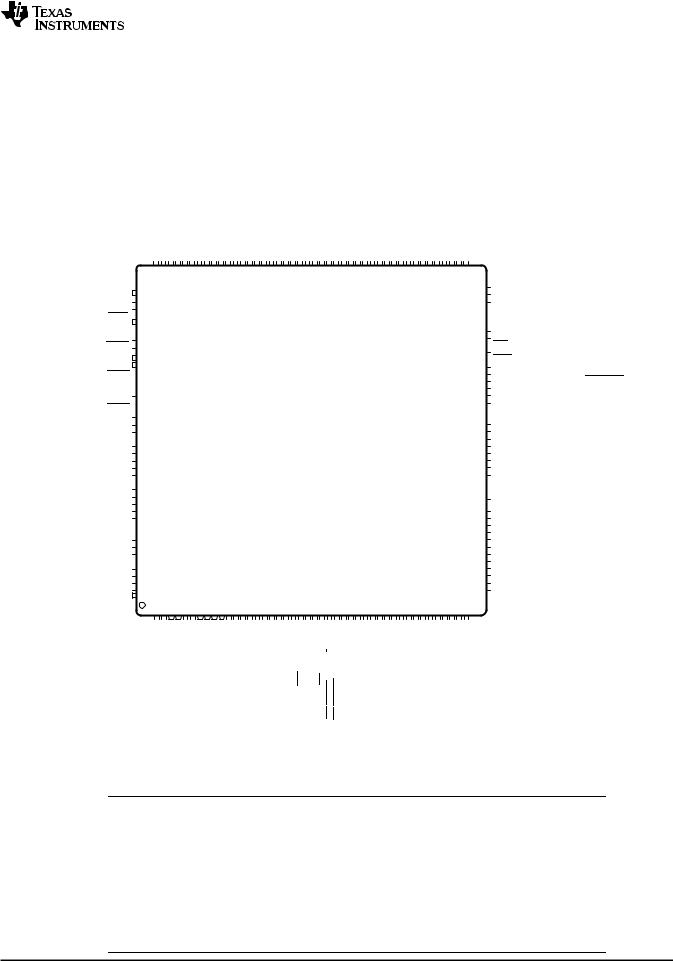
TMS320F28335, TMS320F28334, TMS320F28332
TMS320F28235, TMS320F28234, TMS320F28232
www.ti.com |
SPRS439I –JUNE 2007 –REVISED MARCH 2011 |
2.1Pin Assignments
The 176-pin PGF/PTP low-profile quad flatpack (LQFP) pin assignments are shown in Figure 2-1. The 179-ball ZHH ball grid array (BGA) terminal assignments are shown in Figure 2-2 through Figure 2-5. The 176-ball ZJZ plastic ball grid array (PBGA) terminal assignments are shown in Figure 2-6 through Figure 2-9.Table 2-3 describes the function(s) of each pin.
GPIO76/XD3  133
133
GPIO77/XD2 134
GPIO78/XD1  135
135
GPIO79/XD0  136
136
GPIO38/XWE0  137
137
XCLKOUT 138
VDD  139
139
VSS  140
140
GPIO28/SCIRXDA/XZCS6  141
141
GPIO34/ECAP1/XREADY  142
142
VDDIO 143
VSS 144
GPIO36/SCIRXDA/XZCS0  145
145
VDD  146
146
VSS  147
147
GPIO35/SCITXDA/XR/W  148 XRD
148 XRD  149 GPIO37/ECAP2/XZCS7
149 GPIO37/ECAP2/XZCS7  150
150
GPIO40/XA0/XWE1  151 GPIO41/XA1
151 GPIO41/XA1  152 GPIO42/XA2
152 GPIO42/XA2  153
153
VDD  154
154
VSS  155
155
GPIO43/XA3  156
156
GPIO44/XA4  157
157
GPIO45/XA5  158
158
VDDIO  159
159
VSS  160
160
GPIO46/XA6  161
161
GPIO47/XA7  162
162
GPIO80/XA8  163
163
GPIO81/XA9  164
164
GPIO82/XA10  165
165
VSS  166
166
VDD  167
167
GPIO83/XA11  168
168
GPIO84/XA12  169
169
VDDIO  170
170
VSS  171
171
GPIO85/XA13  172
172
GPIO86/XA14  173
173
GPIO87/XA15  174
174
GPIO39/XA16  175 GPIO31/CANTXA/XA17 176
175 GPIO31/CANTXA/XA17 176
GPIO75/XD4 |
GPIO74/XD5 |
GPIO73/XD6 |
GPIO72/XD7 |
GPIO71/XD8 |
GPIO70/XD9 |
V V GPIO69/XD10 |
||||||||||
|
|
|
|
|
|
|
|
|
|
|
|
DD |
SS |
|
||
|
|
|
|
|
|
|
|
|
|
|
|
|
|
|
|
|
132 |
131 |
130 |
129 |
128 |
127 |
126 |
125 |
124 |
||||||||
1 2 3 4 5 6 7 8 9 |
|||||||||
|
|
|
|
V V |
|
|
|
GPIO2/EPWM2A |
V V |
GPIO30/CANRXA/XA18 GPIO29/SCITXDA/XA19 |
GPIO0/EPWM1A |
GPIO1/EPWM1B/ECAP6/MFSRB |
|||||||
|
|
|
|
SS DD |
|
|
|
|
SS DDIO |
GPIO68/XD11 |
GPIO67/XD12 |
V V GPIO66/XD13 |
V V |
|||||||||
|
|
|
|
DDIO |
SS |
|
|
SS |
DD |
|||
|
|
|
|
|
|
|
|
|
|
|
|
|
123 |
122 |
121 |
120 |
119 |
118 |
117 |
||||||
10 11 12 13 14 15 16 |
|||||||||||
GPIO3/EPWM2B/ECAP5/MCLKRB |
|
|
|
|
|
|
|
|
|
||
GPIO4/EPWM3A GPIO5/EPWM3B/MFSRA/ECAP1 GPIO6/EPWM4A/EPWMSYNCI/EPWMSYNCO |
V V GPIO7/EPWM4B/MCLKRA/ECAP2 |
||||||||||
|
|
|
|
|
|
|
SS DD |
||||
GPIO65/XD14 |
GPIO64/XD15 |
GPIO63/SCITXDC/XD16 |
GPIO62/SCIRXDC/XD17 |
GPIO61/MFSRB/XD18 |
GPIO60/MCLKRB/XD19 |
GPIO59/MFSRA/XD20 |
V V V |
|||||||||||
|
|
|
|
|
|
|
|
|
|
|
|
|
|
DD |
SS |
DDIO |
||
|
|
|
|
|
|
|
|
|
|
|
|
|
|
|
|
|
|
|
116 |
|
115 |
|
114 |
113 |
112 |
111 |
110 |
109 |
108 |
107 |
|||||||
17 18 19 20 |
21 22 23 24 25 26 |
||||||||||||||||
|
|
|
|
|
|
|
|
|
|
|
|
|
|
|
|
||
GPIO8/EPWM5A/CANTXB/ADCSOCAO GPIO9/EPWM5B/SCITXDB/ECAP3 GPIO10/EPWM6A/CANRXB/ADCSOCBO GPIO11/EPWM6B/SCIRXDB/ECAP4 |
GPIO12/TZ1/CANTXB/MDXB |
V V GPIO13/TZ2/CANRXB/MDRB |
|
/XHOLD/GPIO14/TZ3SCITXDB/MCLKXB |
|
GPIO15/TZ4/XHOLDA/SCIRXDB/MFSXB |
|||||||||||
|
|
|
|
|
|
|
|
|
SS DD |
|
|
|
|
||||
V XCLKIN |
X1 |
V X2 |
V GPIO58/MCLKRA/XD21 |
|
GPIO57/SPISTEA/XD22 GPIO56/SPICLKA/XD23 |
||||||||||||
|
|||||||||||||||||
|
|||||||||||||||||
SS |
|
|
|
SS |
DD |
|
|
|
|||||||||
|
|
|
|
|
|
|
|
|
|
|
|
|
|
|
|
|
|
106 105 104 103 102 101 100 |
|
99 98 |
|||||||||||||||
27 28 29 30 31 32 33 34 35 |
|||||||||||||||
|
|
|
|
|
|
|
|
|
|
|
|
|
|
|
|
|
|
|
DD SS |
DD1A18 |
SS1AGND SSA2 DDA2 |
||||||||||
|
|
|
|||||||||||||
GPIO16/SPISIMOA/CANTXB/TZ5 GPIO17/SPISOMIA/CANRXB/TZ6 |
|
|
|
|
|
||||||||||
V V |
V |
V V V ADCINA7 |
|||||||||||||
GPIO55/SPISOMIA/XD24 GPIO54/SPISIMOA/XD25 GPIO53/EQEP1I/XD26 GPIO52/EQEP1S/XD27 V V GPIO51/EQEP1B/XD28 |
GPIO50/EQEP1A/XD29 GPIO49/ECAP6/XD30 |
|||||||||||||||
|
|
|
|
|
|
|
|
DDIO SS |
|
|
|
|
||||
|
|
|
|
|
|
|
|
|
|
|
|
|
|
|
|
|
97 96 95 94 93 92 91 90 89 |
||||||||||||||||
36 37 38 39 40 41 42 43 44 |
||||||||||||||||
|
|
|
|
|
|
|
|
|
|
|
|
|
|
|
|
|
ADCINA6 ADCINA5 ADCINA4 ADCINA3 ADCINA2 ADCINA1 ADCINA0 |
ADCLO V |
|||||||||||||||
|
|
|
|
|
|
|
|
|
|
|
|
|
|
|
|
SSAIO |
88  GPIO48/ECAP5/XD31
GPIO48/ECAP5/XD31
87  TCK
TCK
86  EMU1
EMU1
85  EMU0
EMU0
84  VDD3VFL
VDD3VFL
83  VSS
VSS
82  TEST2
TEST2
81  TEST1
TEST1
80  XRS
XRS
79  TMS
TMS
78  TRST
TRST
77  TDO
TDO
76  TDI
TDI
75  GPIO33/SCLA/EPWMSYNCO/ADCSOCBO
GPIO33/SCLA/EPWMSYNCO/ADCSOCBO
74  GPIO32/SDAA/EPWMSYNCI/ADCSOCAO
GPIO32/SDAA/EPWMSYNCI/ADCSOCAO
73  GPIO27/ECAP4/EQEP2S/MFSXB
GPIO27/ECAP4/EQEP2S/MFSXB
72  GPIO26/ECAP3/EQEP2I/MCLKXB
GPIO26/ECAP3/EQEP2I/MCLKXB
71  VDDIO
VDDIO
70  VSS
VSS
69  GPIO25/ECAP2/EQEP2B/MDRB
GPIO25/ECAP2/EQEP2B/MDRB
68  GPIO24/ECAP1/EQEP2A/MDXB
GPIO24/ECAP1/EQEP2A/MDXB
67  GPIO23/EQEP1I/MFSXA/SCIRXDB
GPIO23/EQEP1I/MFSXA/SCIRXDB
66  GPIO22/EQEP1S/MCLKXA/SCITXDB
GPIO22/EQEP1S/MCLKXA/SCITXDB
65  GPIO21/EQEP1B/MDRA/CANRXB
GPIO21/EQEP1B/MDRA/CANRXB
64  GPIO20/EQEP1A/MDXA/CANTXB
GPIO20/EQEP1A/MDXA/CANTXB
63  GPIO19/SPISTEA/SCIRXDB/CANTXA
GPIO19/SPISTEA/SCIRXDB/CANTXA
62  GPIO18/SPICLKA/SCITXDB/CANRXA
GPIO18/SPICLKA/SCITXDB/CANRXA
61  VDD
VDD
60  VSS
VSS
59  VDD2A18
VDD2A18
58  VSS2AGND
VSS2AGND
57  ADCRESEXT
ADCRESEXT
56  ADCREFP
ADCREFP
55  ADCREFM
ADCREFM
54  ADCREFIN
ADCREFIN
53  ADCINB7
ADCINB7
52  ADCINB6
ADCINB6
51  ADCINB5
ADCINB5
50  ADCINB4
ADCINB4
49  ADCINB3
ADCINB3
48  ADCINB2
ADCINB2
47  ADCINB1
ADCINB1
46  ADCINB0
ADCINB0
45  VDDAIO
VDDAIO
Figure 2-1. F2833x, F2823x 176-Pin PGF/PTP LQFP (Top View)
NOTE
The powerpad on the bottom side of the PTP package is not connected to the ground (GND) of the die. Proper thermal management of the PowerPAD™ package requires PCB preparation. A thermal land is required on the surface of the PCB directly underneath the body of the PowerPAD package. The size of the thermal land should be as large as needed to dissipate the required heat. Note that the PowerPAD package with exposed pad down must be soldered to the PCB. Refer to the PowerPAD™ Thermally Enhanced Package Application Report (literature number SLMA002) for more details on using the PowerPAD package.
Copyright © 2007–2011, Texas Instruments Incorporated |
Introduction |
15 |
Submit Documentation Feedback
Product Folder Link(s): TMS320F28335 TMS320F28334 TMS320F28332 TMS320F28235 TMS320F28234
TMS320F28232
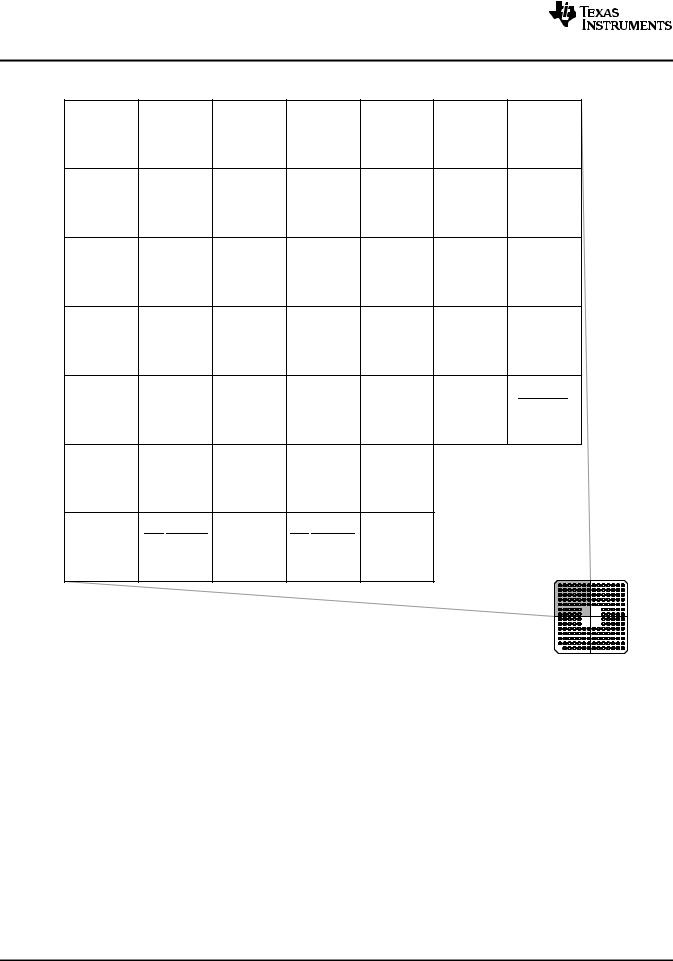
TMS320F28335, TMS320F28334, TMS320F28332
TMS320F28235, TMS320F28234, TMS320F28232
SPRS439I–JUNE 2007 –REVISED MARCH 2011 |
|
|
|
|
|
www.ti.com |
|||
|
1 |
2 |
3 |
4 |
5 |
6 |
7 |
|
|
|
|
|
|
|
|
|
GPIO21/ |
|
|
P |
VSSAIO |
ADCINB0 |
ADCINB2 |
ADCINB6 |
ADCREFP |
VSS |
EQEP1B/ |
P |
|
MDRA/ |
|||||||||
|
|
|
|
|
|
|
CANRXB |
|
|
|
|
|
|
|
|
|
GPIO22/ |
|
|
N |
ADCINA1 |
VDDAIO |
ADCINB1 |
ADCINB5 |
ADCREFM |
VDD |
EQEP1S/ |
N |
|
MCLKXA/ |
|||||||||
|
|
|
|
|
|
|
SCITXDB |
|
|
|
|
|
|
|
|
|
GPIO23/ |
|
|
M |
ADCINA2 |
ADCLO |
ADCINA0 |
ADCINB4 |
ADCRESEXT |
VDD2A18 |
EQEP1I/ |
M |
|
MFSXA/ |
|||||||||
|
|
|
|
|
|
|
SCIRXDB |
|
|
|
|
|
|
|
|
GPIO18/ |
GPIO20/ |
|
|
L |
ADCINA5 |
ADCINA4 |
ADCINA3 |
ADCINB3 |
ADCREFIN |
SPICLKA/ |
EQEP1A/ |
L |
|
SCITXDB/ |
MDXA/ |
||||||||
|
|
|
|
|
|
|
|||
|
|
|
|
|
|
CANRXA |
CANTXB |
|
|
|
|
|
|
|
|
|
GPIO19/ |
|
|
K |
VSS1AGND |
VDDA2 |
VSSA2 |
ADCINA7 |
ADCINB7 |
VSS2AGND |
SPISTEA/ |
K |
|
SCIRXDB/ |
|||||||||
|
|
|
|
|
|
|
CANTXA |
|
|
|
GPIO17/ |
|
|
|
|
6 |
7 |
|
|
|
|
|
|
|
|
|
|
||
J |
SPISOMIA/ |
VDD |
VSS |
VDD1A18 |
ADCINA6 |
J |
|
|
|
CANRXB/ |
|
|
|||||||
|
TZ6 |
|
|
|
|
|
|
|
|
|
|
GPIO14/ |
GPIO13/ |
GPIO15/ |
GPIO16/ |
|
|
|
|
H |
VDD |
TZ3 XHOLD/ |
TZ2/ |
TZ4 XHOLDA/ |
SPISIMOA/ |
H |
|
|
|
SCITXDB/ |
CANRXB/ |
SCIRXDB/ |
CANTXB/ |
|
|
||||
|
|
|
|
||||||
|
|
MCLKXB |
MDRB |
MFSXB |
TZ5 |
|
|
|
|
|
1 |
2 |
3 |
4 |
5 |
|
|
|
|
Figure 2-2. F2833x, F2823x 179-Ball ZHH MicroStar BGA™ (Upper Left Quadrant) (Bottom View)
16 |
Introduction |
Copyright © 2007–2011, Texas Instruments Incorporated |
Submit Documentation Feedback
Product Folder Link(s): TMS320F28335 TMS320F28334 TMS320F28332 TMS320F28235 TMS320F28234
TMS320F28232
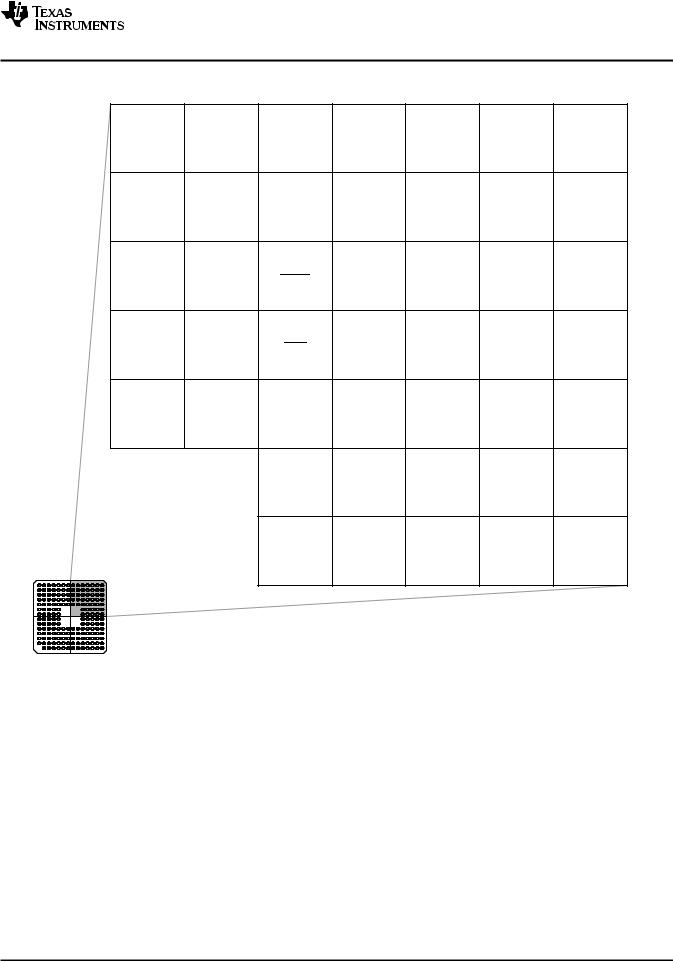
TMS320F28335, TMS320F28334, TMS320F28332
TMS320F28235, TMS320F28234, TMS320F28232
www.ti.com SPRS439I –JUNE 2007 –REVISED MARCH 2011
|
8 |
9 |
10 |
11 |
12 |
13 |
14 |
|
|
|
|
GPIO33/ |
|
|
|
GPIO48/ |
GPIO50/ |
|
|
|
|
SCLA/ |
|
|
|
|
|||
P |
VSS |
TMS |
TEST2 |
EMU1 |
ECAP5/ |
EQEP1A/ |
P |
||
EPWMSYNCO/ |
|||||||||
|
|
|
|
|
XD31 |
XD29 |
|
||
|
|
ADCSOCBO |
|
|
|
|
|||
|
|
|
|
|
|
|
|
||
|
GPIO25/ |
GPIO32/ |
|
|
|
GPIO49/ |
|
|
|
|
ECAP2/ |
SDAA/ |
|
|
|
|
|
||
N |
VSS |
VSS |
TCK |
ECAP6/ |
VDDIO |
N |
|||
EQEP2B/ |
EPWMSYNCI/ |
||||||||
|
|
|
|
XD30 |
|
|
|||
|
MDRB |
ADCSOCAO |
|
|
|
|
|
||
|
|
|
|
|
|
|
|||
|
GPIO24/ |
|
|
|
|
GPIO51/ |
GPIO52/ |
|
|
|
ECAP1/ |
|
|
|
|
|
|||
M |
TDI |
TRST |
VDD3VFL |
VSS |
EQEP1B/ |
EQEP1S/ |
M |
||
EQEP2A/ |
|||||||||
|
|
|
|
|
XD28 |
XD27 |
|
||
|
MDXB |
|
|
|
|
|
|||
|
|
|
|
|
|
|
|
||
|
|
GPIO27/ |
|
|
GPIO53/ |
GPIO54/ |
GPIO55/ |
|
|
|
|
ECAP4/ |
|
|
|
||||
L |
VDDIO |
XRS |
EMU0 |
EQEP1I/ |
SPISIMOA/ |
SPISOMIA/ |
L |
||
EQEP2S/ |
|||||||||
|
|
|
|
XD26 |
XD25 |
XD24 |
|
||
|
|
MFSXB |
|
|
|
||||
|
|
|
|
|
|
|
|
||
|
GPIO26/ |
|
|
GPIO56/ |
GPIO58/ |
GPIO57/ |
|
|
|
|
ECAP3/ |
|
|
|
|
||||
K |
TDO |
TEST1 |
SPICLKA/ |
MCLKRA/ |
SPISTEA/ |
VDD |
K |
||
EQEP2I/ |
|||||||||
|
|
|
XD23 |
XD21 |
XD22 |
|
|
||
|
MCLKXB |
|
|
|
|
||||
|
|
|
|
|
|
|
|
||
|
8 |
9 |
|
|
|
|
|
|
|
|
|
J |
VSS |
X2 |
VSS |
X1 |
XCLKIN |
J |
|
|
|
|
|
|
|
|
GPIO59/ |
|
|
|
|
H |
VSS |
VDDIO |
VDD |
VSS |
MFSRA/ |
H |
|
|
|
|
|
|
|
|
XD20 |
|
|
|
|
|
10 |
11 |
12 |
13 |
14 |
|
Figure 2-3. F2833x, F2823x 179-Ball ZHH MicroStar BGA™ (Upper Right Quadrant) (Bottom View)
Copyright © 2007–2011, Texas Instruments Incorporated |
Introduction |
17 |
Submit Documentation Feedback
Product Folder Link(s): TMS320F28335 TMS320F28334 TMS320F28332 TMS320F28235 TMS320F28234
TMS320F28232
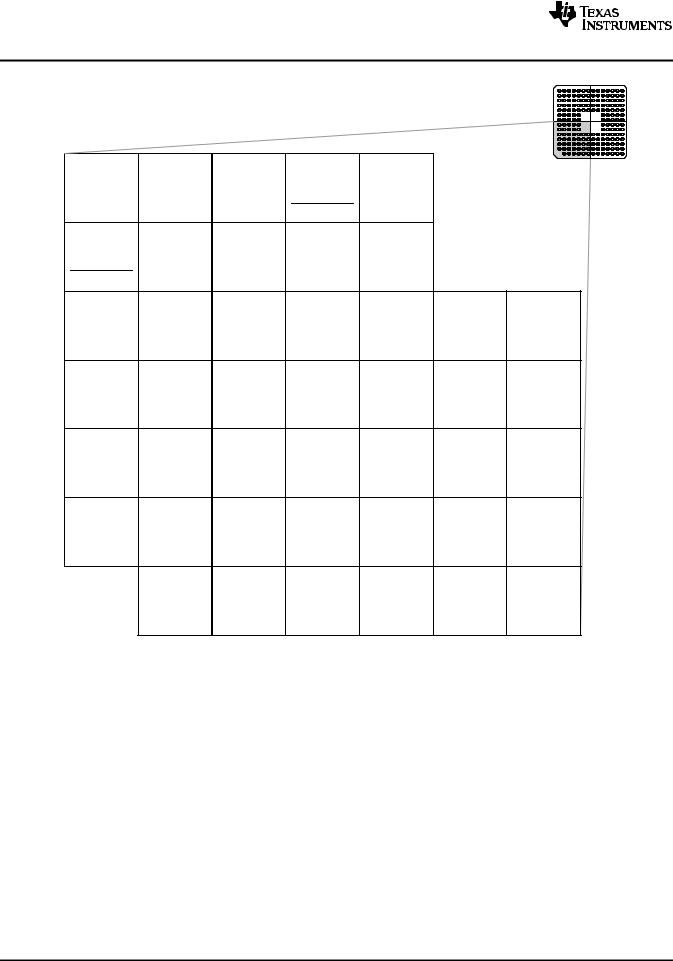
TMS320F28335, TMS320F28334, TMS320F28332 |
|
|
|
|
|||||
TMS320F28235, TMS320F28234, TMS320F28232 |
|
|
|
|
|||||
SPRS439I–JUNE 2007 –REVISED MARCH 2011 |
|
|
|
|
|
www.ti.com |
|||
|
1 |
2 |
3 |
4 |
5 |
|
|
|
|
|
|
GPIO11/ |
GPIO12/ |
GPIO10/ |
GPIO9/ |
|
|
|
|
G |
VSS |
EPWM6B/ |
TZ1/ |
EPWM6A/ |
EPWM5B/ |
G |
|
|
|
SCIRXDB/ |
CANTXB/ |
CANRXB/ |
SCITXDB/ |
|
|
||||
|
|
ECAP4 |
MDXB |
ADCSOCBO |
ECAP3 |
|
|
|
|
|
GPIO8/ |
GPIO7/ |
|
|
|
|
|
|
|
F |
EPWM5A/ |
EPWM4B/ |
VDD |
VSS |
VDDIO |
F |
|
|
|
CANTXB/ |
MCLKRA/ |
|
|
||||||
|
ADCSOCAO |
ECAP2 |
|
|
|
6 |
7 |
|
|
|
GPIO6/ |
|
GPIO5/ |
GPIO3/ |
|
|
|
|
|
E |
EPWM4A/ |
GPIO4/ |
EPWM3B/ |
EPWM2B/ |
GPIO84/ |
GPIO81/ |
VDDIO |
E |
|
EPWMSYNCI/ |
EPWM3A |
MFSRA/ |
ECAP5/ |
XA12 |
XA9 |
||||
|
EPWMSYNCO |
|
ECAP1 |
MCLKRB |
|
|
|
|
|
|
|
|
GPIO1/ |
|
|
|
|
|
|
D |
VSS |
GPIO2/ |
EPWM1B/ |
GPIO86/ |
GPIO83/ |
VSS |
GPIO45/ |
D |
|
EPWM2A |
ECAP6/ |
XA14 |
XA11 |
XA5 |
|||||
|
|
|
MFSRB |
|
|
|
|
|
|
|
GPIO0/ |
GPIO29/ |
|
GPIO85/ |
GPIO82/ |
GPIO80/ |
|
|
|
C |
SCITXDA/ |
VSS |
VSS |
C |
|||||
EPWM1A |
XA13 |
XA10 |
XA8 |
||||||
|
XA19 |
|
|
|
|||||
|
|
|
|
|
|
|
|
||
|
|
GPIO30/ |
GPIO39/ |
|
|
GPIO46/ |
GPIO43/ |
|
|
B |
VDD |
CANRXA/ |
VSS |
VDD |
B |
||||
XA16 |
XA6 |
XA3 |
|||||||
|
|
XA18 |
|
|
|
||||
|
|
|
|
|
|
|
|
||
|
|
GPIO31/ |
GPIO87/ |
|
|
GPIO47/ |
GPIO44/ |
|
|
A |
|
CANTXA/ |
VDDIO |
VSS |
A |
||||
|
XA15 |
XA7 |
XA4 |
||||||
|
|
XA17 |
|
|
|
||||
|
|
|
|
|
|
|
|
||
|
1 |
2 |
3 |
4 |
5 |
6 |
7 |
|
|
Figure 2-4. F2833x, F2823x 179-Ball ZHH MicroStar BGA™ (Lower Left Quadrant) (Bottom View) |
|||||||||
18 |
Introduction |
Copyright © 2007–2011, Texas Instruments Incorporated |
Submit Documentation Feedback
Product Folder Link(s): TMS320F28335 TMS320F28334 TMS320F28332 TMS320F28235 TMS320F28234
TMS320F28232

TMS320F28335, TMS320F28334, TMS320F28332
TMS320F28235, TMS320F28234, TMS320F28232
www.ti.com |
SPRS439I –JUNE 2007 –REVISED MARCH 2011 |
|
|
|
|
|
|
|
10 |
11 |
12 |
13 |
14 |
|
|
|
|
|
GPIO64/ |
GPIO63/ |
GPIO61/ |
GPIO62/ |
GPIO60/ |
|
|
|
|
G |
SCITXDC/ |
MFSRB/ |
SCIRXDC |
MCLKRB/ |
G |
||
|
|
XD15 |
|||||||
|
|
|
XD16 |
XD18 |
XD17 |
XD19 |
|
||
|
|
|
|
|
|||||
|
|
F |
GPIO69/ |
GPIO66/ |
VSS |
VDD |
GPIO65/ |
F |
|
|
|
XD10 |
XD13 |
XD14 |
|||||
|
8 |
9 |
|
|
|
|
|
|
|
|
|
|
GPIO28/ |
GPIO68/ |
|
GPIO67/ |
|
|
|
E |
VSS |
VDD |
SCIRXDA/ |
VDDIO |
VSS |
E |
|||
XD11 |
XD12 |
||||||||
|
|
|
XZCS6 |
|
|
|
|||
|
|
|
|
|
|
|
|
||
|
GPIO40/ |
GPIO37/ |
GPIO34/ |
GPIO38/ |
GPIO70/ |
|
|
|
|
D |
XA0/ |
ECAP2/ |
ECAP1/ |
VDD |
VSS |
D |
|||
XWE0 |
XD9 |
||||||||
|
XWE1 |
XZCS7 |
XREADY |
|
|
|
|||
|
|
|
|
|
|
||||
|
|
|
GPIO36/ |
|
GPIO73/ |
GPIO74/ |
GPIO71/ |
|
|
C |
VDD |
VSS |
SCIRXDA/ |
XCLKOUT |
C |
||||
XD6 |
XD5 |
XD8 |
|||||||
|
|
|
XZCS0 |
|
|
||||
|
|
|
|
|
|
|
|
||
B |
GPIO42/ |
XRD |
VDDIO |
VDD |
GPIO78/ |
GPIO76/ |
GPIO72/ |
B |
|
XA2 |
XD1 |
XD3 |
XD7 |
||||||
|
GPIO41/ |
GPIO35/ |
|
|
GPIO79/ |
GPIO77/ |
GPIO75/ |
|
|
A |
SCITXDA/ |
VSS |
VSS |
A |
|||||
XA1 |
XD0 |
XD2 |
XD4 |
||||||
|
XR/W |
|
|
|
|||||
|
|
|
|
|
|
|
|
||
|
8 |
9 |
10 |
11 |
12 |
13 |
14 |
|
Figure 2-5. F2833x, F2823x 179-Ball ZHH MicroStar BGA ™ (Lower Right Quadrant) (Bottom View)
Copyright © 2007–2011, Texas Instruments Incorporated |
Introduction |
19 |
Submit Documentation Feedback
Product Folder Link(s): TMS320F28335 TMS320F28334 TMS320F28332 TMS320F28235 TMS320F28234
TMS320F28232
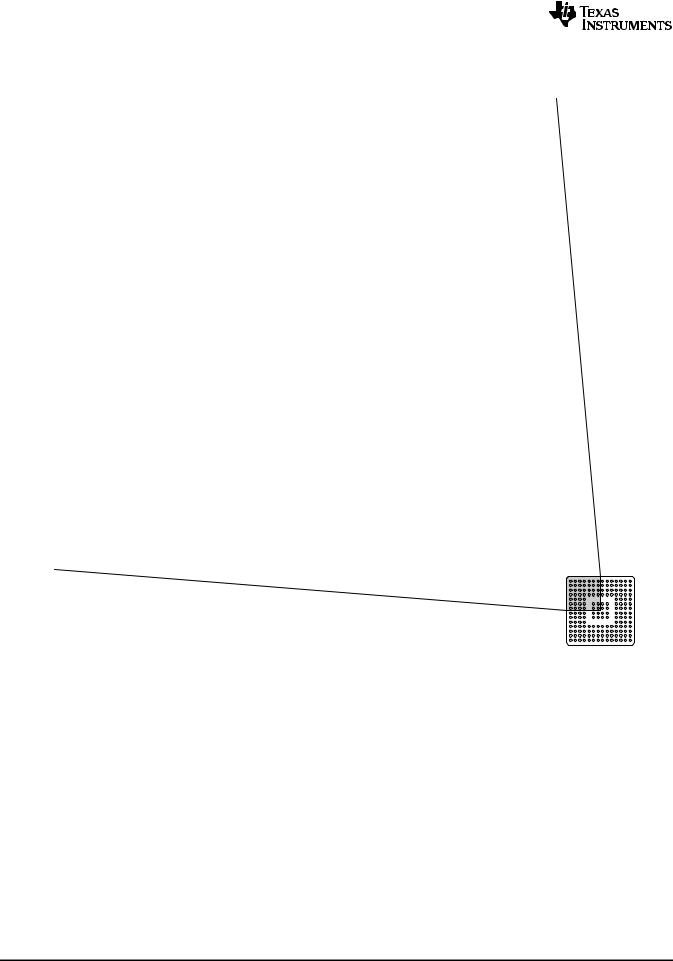
TMS320F28335, TMS320F28334, TMS320F28332
TMS320F28235, TMS320F28234, TMS320F28232
SPRS439I–JUNE 2007 –REVISED MARCH 2011 |
|
|
|
|
|
|
www.ti.com |
||||||||||||
|
1 |
|
2 |
3 |
|
4 |
5 |
6 |
7 |
|
|
|
|
||||||
|
|
|
|
|
|
|
|
|
|
|
|
|
|
|
|
||||
P |
|
|
|
VSSA2 |
VSS2AGND |
|
ADCINB0 |
ADCREFM |
ADCREFP |
ADCRESEXT |
ADCREFIN |
|
|
|
|
||||
|
|
|
|
|
|
|
|
|
|
|
|
|
|
|
|||||
N |
|
|
VSSAIO |
ADCLO |
|
ADCINB1 |
ADCINB3 |
ADCINB5 |
ADCINB7 |
EMU0 |
|
|
|
|
|||||
|
|
|
|
|
|
|
|
|
|
|
|
|
|
||||||
M |
|
ADCINA2 |
ADCINA1 |
|
ADCINA0 |
ADCINB2 |
ADCINB4 |
ADCINB6 |
TEST1 |
|
|
|
|
||||||
|
|
|
|
|
|
|
|
|
|
|
|
|
|
||||||
L |
|
ADCINA5 |
ADCINA4 |
|
ADCINA3 |
VSS1AGND |
VDDAIO |
VDD2A18 |
TEST2 |
|
|
|
|
||||||
|
|
|
|
|
|
|
|
|
|
|
|
|
|
||||||
K |
|
ADCINA7 |
ADCINA6 |
|
VDD1A18 |
VDDA2 |
|
|
|
|
|
|
|
||||||
|
|
|
|
|
|
|
|
|
|
|
|
|
|
||||||
|
|
GPIO15/ |
GPIO16/ |
|
GPIO17/ |
|
|
|
|
|
|
|
|
||||||
|
|
|
|
|
|
|
|
|
|
|
|
|
|
|
|
|
|
|
|
J |
TZ4/XHOLDA/ |
SPISIMOA/ |
|
SPISOMIA/ |
VDD |
|
VSS |
VSS |
|
|
|
|
|||||||
|
SCIRXDB/ |
CANTXB/ |
|
CANRXB/ |
|
|
|
|
|
||||||||||
|
|
MFSXB |
TZ5 |
|
|
TZ6 |
|
|
|
|
|
|
|
|
|||||
|
|
|
|
|
|
|
|
|
|
|
|
|
|
||||||
|
|
GPIO12/ |
GPIO13/ |
|
GPIO14/ |
|
|
|
|
|
|
|
|
||||||
|
|
|
|
|
|
|
|
|
|
|
|
|
|
|
|
|
|
|
|
H |
|
|
|
TZ1/ |
TZ2/ |
TZ3 XHOLD/ |
VDD |
|
VSS |
VSS |
|
|
|
|
|||||
|
CANTXB/ |
CANRXB/ |
|
SCITXDB/ |
|
|
|
|
|
||||||||||
|
|
|
MDXB |
MDRB |
|
MCLKXB |
|
|
|
|
|
|
|
|
|||||
|
|
|
|
|
|
|
|
|
|
|
|
|
|
|
|
|
|
|
|
|
|
|
|
|
|
|
|
|
|
|
|
|
|
|
|
|
|
|
|
|
|
|
|
|
|
|
|
|
|
|
|
|
|
|
|
|
|
|
|
|
|
|
|
|
|
|
|
|
|
|
|
|
|
|
|
|
|
|
|
Figure 2-6. F2833x, F2823x 176-Ball ZJZ Plastic BGA (Upper Left Quadrant) (Bottom View)
20 |
Introduction |
Copyright © 2007–2011, Texas Instruments Incorporated |
Submit Documentation Feedback
Product Folder Link(s): TMS320F28335 TMS320F28334 TMS320F28332 TMS320F28235 TMS320F28234
TMS320F28232

TMS320F28335, TMS320F28334, TMS320F28332
TMS320F28235, TMS320F28234, TMS320F28232
www.ti.com SPRS439I –JUNE 2007 –REVISED MARCH 2011
8 |
9 |
10 |
11 |
12 |
13 |
14 |
|
|
|
|
|
|
|
|
|
|
|
|
GPIO20/ |
GPIO23/ |
GPIO26/ |
GPIO33/ |
|
|
|
|
EMU1 |
EQEP1A/ |
EQEP1I/ |
ECAP3/ |
SCLA/ |
VSS |
VSS |
P |
|
MDXA/ |
MFSXA/ |
EQEP2I/ |
EPWMSYNCO/ |
|||||
|
CANTXB |
SCIRXDB |
MCLKXB |
ADCSOCBO |
|
|
|
|
|
|
|
|
|
|
|
|
|
GPIO18/ |
GPIO21/ |
GPIO24/ |
GPIO27/ |
|
|
|
|
|
SPICLKA/ |
EQEP1B/ |
ECAP1/ |
ECAP4/ |
TDI |
TDO |
VDDIO |
N |
|
SCITXDB/ |
MDRA/ |
EQEP2A/ |
EQEP2S/ |
|||||
CANRXA |
CANRXB |
MDXB |
MFSXB |
|
|
|
|
|
|
|
|
|
|
|
|
|
|
GPIO19/ |
GPIO22/ |
GPIO25/ |
GPIO32/ |
|
|
|
|
|
SPISTEA/ |
EQEP1S/ |
ECAP2/ |
SDAA/ |
TMS |
XRS |
TCK |
M |
|
SCIRXDB/ |
MCLKXA/ |
EQEP2B/ |
EPWMSYNCI/ |
|||||
|
|
|
|
|||||
CANTXA |
SCITXDB |
MDRB |
ADSOCAO |
|
|
|
|
|
|
|
|
|
|
|
|
|
|
|
|
|
|
GPIO50/ |
GPIO49/ |
GPIO48/ |
|
|
VDD |
VDD3VFL |
VDDIO |
TRST |
EQEP1A/ |
ECAP6/ |
ECAP5/ |
L |
|
|
|
|
|
XD29 |
XD30 |
XD31 |
|
|
|
|
|
|
|
|
|
|
|
|
|
|
|
GPIO53 |
GPIO52/ |
GPIO51/ |
|
|
|
|
|
VDD |
EQEP1I/ |
EQEP1S/ |
EQEP1B/ |
K |
|
|
|
|
|
XD26 |
XD27 |
XD28 |
|
|
|
|
|
|
|
|
|
|
|
|
|
|
|
GPIO56/ |
GPIO55/ |
GPIO54/ |
|
|
VSS |
VSS |
|
VDD |
SPICLKA/ |
SPISOMIA/ |
SPISIMOA/ |
J |
|
|
|
|
|
XD23 |
XD24 |
XD25 |
|
|
|
|
|
|
|
|
|
|
|
|
|
|
GPIO59/ |
GPIO58/ |
GPIO57/ |
|
|
|
VSS |
VSS |
|
MFSRA/ |
MCLKRA/ |
SPISTEA/ |
X2 |
H |
|
|
|
|
XD20 |
XD21 |
XD22 |
|
|
|
|
|
|
|
|
|
|
|
Figure 2-7. F2833x, F2823x 176-Ball ZJZ Plastic BGA (Upper Right Quadrant) (Bottom View)
Copyright © 2007–2011, Texas Instruments Incorporated |
Introduction |
21 |
Submit Documentation Feedback
Product Folder Link(s): TMS320F28335 TMS320F28334 TMS320F28332 TMS320F28235 TMS320F28234
TMS320F28232
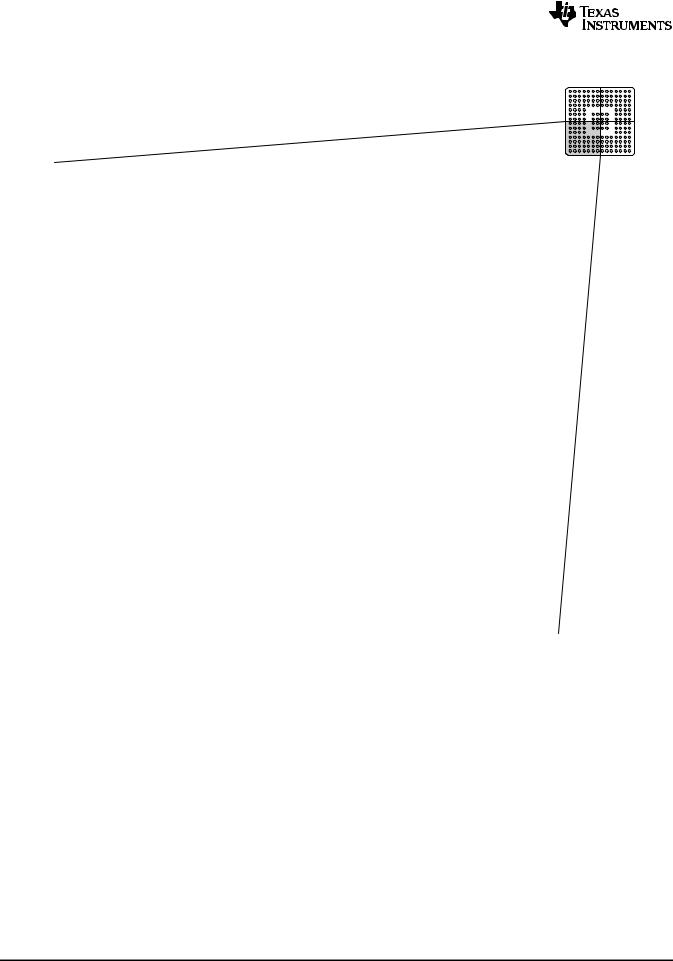
TMS320F28335, TMS320F28334, TMS320F28332
TMS320F28235, TMS320F28234, TMS320F28232
SPRS439I–JUNE 2007 –REVISED MARCH 2011 |
www.ti.com |
|
GPIO9/ |
|
GPIO10/ |
|
GPIO11/ |
|
|
|
|
||
G |
EPWM5B/ |
|
EPWM6A/ |
|
EPWM6B/ |
VDDIO |
|
VSS |
VSS |
||
SCITXDB/ |
|
CANRXB/ |
|
SCIRXDB/ |
|
||||||
|
|
|
|
|
|
|
|||||
|
ECAP3 |
|
|
|
|
|
|
|
|
|
|
|
ADCSOCBO |
|
ECAP4 |
|
|
|
|
||||
|
|
|
|
|
|
|
|
|
|
|
|
|
GPIO6/ |
|
GPIO7/ |
|
GPIO8/ |
|
|
|
|
||
F |
EPWM4A/ |
|
EPWM4B/ |
|
EPWM5A/ |
VDD |
|
VSS |
VSS |
||
EPWMSYNCI/ |
|
MCLKRA/ |
|
CANTXB/ |
|
||||||
|
|
|
|
|
|
|
|||||
|
|
|
|
|
|
|
|
|
|
|
|
|
EPWMSYNCO |
|
ECAP2 |
|
ADCSOCAO |
|
|
|
|
||
|
|
|
|
|
|
|
|
|
|
|
|
|
GPIO3/ |
|
|
|
|
GPIO5/ |
|
|
|
|
|
E |
EPWM2B/ |
|
GPIO4/ |
|
EPWM3B/ |
VDDIO |
|
|
|
||
ECAP5/ |
|
EPWM3A |
|
MFSRA/ |
|
|
|
||||
|
|
|
|
|
|
|
|||||
|
MCLKRB |
|
|
|
|
ECAP1 |
|
|
|
|
|
|
|
|
|
|
|
|
|
|
|
|
|
|
|
|
GPIO1/ |
|
|
|
|
|
|
|
|
D |
GPIO0/ |
|
EPWM1B/ |
|
GPIO2/ |
VDD |
VDD |
GPIO47/ |
VDDIO |
||
EPWM1A |
|
ECAP6/ |
|
EPWM2A |
XA7 |
||||||
|
|
|
|
|
|
||||||
|
|
|
MFSRB |
|
|
|
|
|
|
|
|
|
|
|
|
|
|
|
|
|
|
|
|
|
GPIO29/ |
|
GPIO30/ |
|
GPIO39/ |
GPIO85/ |
GPIO82/ |
GPIO46/ |
GPIO43/ |
||
C |
SCITXDA/ |
|
CANRXA/ |
|
|||||||
|
|
XA16 |
XA13 |
XA10 |
XA6 |
XA3 |
|||||
|
XA19 |
|
XA18 |
|
|||||||
|
|
|
|
|
|
|
|
|
|||
|
|
|
|
|
|
|
|
|
|
|
|
|
|
|
GPIO31/ |
|
GPIO87/ |
GPIO84/ |
GPIO81/ |
GPIO45/ |
GPIO42/ |
||
B |
VDDIO |
|
CANTXA/ |
|
|||||||
|
|
XA15 |
XA12 |
XA9 |
XA5 |
XA2 |
|||||
|
|
|
XA17 |
|
|||||||
|
|
|
|
|
|
|
|
|
|
||
|
|
|
|
|
|
|
|
|
|
|
|
A |
VSS |
|
VSS |
|
GPIO86/ |
GPIO83/ |
GPIO80/ |
GPIO44/ |
GPIO41/ |
||
|
|
XA14 |
XA11 |
XA8 |
XA4 |
XA1 |
|||||
|
|
|
|
|
|
||||||
|
|
|
|
|
|
|
|
|
|
|
|
|
1 |
2 |
|
3 |
|
4 |
5 |
6 |
7 |
||
Figure 2-8. F2833x, F2823x 176-Ball ZJZ Plastic BGA (Lower Left Quadrant) (Bottom View)
22 |
Introduction |
Copyright © 2007–2011, Texas Instruments Incorporated |
Submit Documentation Feedback
Product Folder Link(s): TMS320F28335 TMS320F28334 TMS320F28332 TMS320F28235 TMS320F28234
TMS320F28232
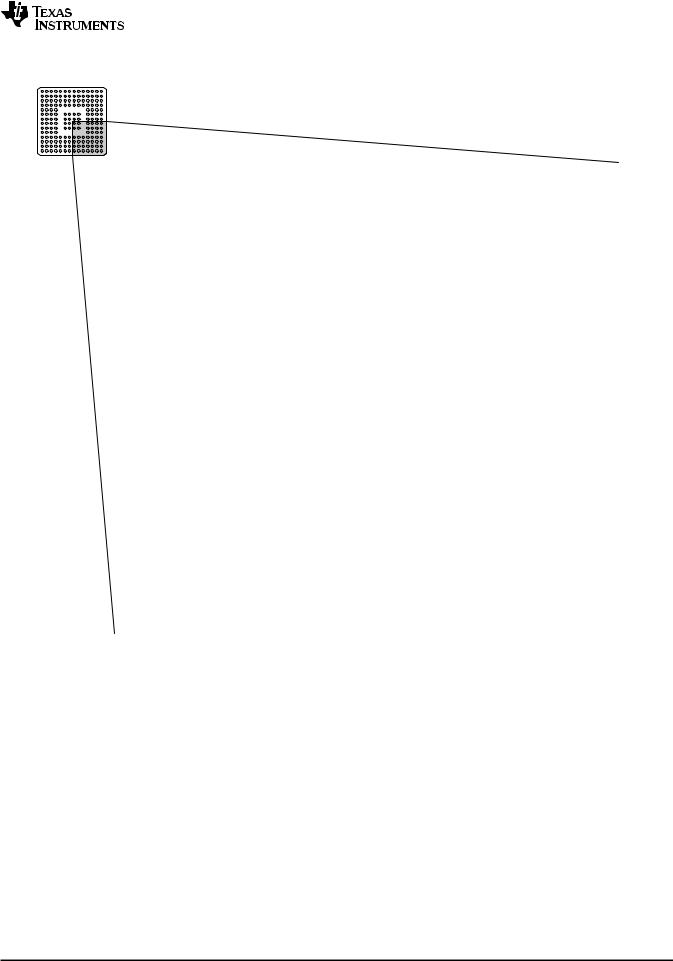
TMS320F28335, TMS320F28334, TMS320F28332
TMS320F28235, TMS320F28234, TMS320F28232
www.ti.com |
SPRS439I –JUNE 2007 –REVISED MARCH 2011 |
||
|
|
|
|
|
|
|
|
|
|
|
|
|
|
|
|
|
|
|
|
GPIO60/ |
|
|
|
|
|
VSS |
VSS |
|
VDDIO |
MCLKRB/ |
XCLKIN |
X1 |
G |
||||
|
|
|
|
|
|
|
|
XD19 |
|
|
|
|
|
|
|
|
|
|
|
|
|
|
|
|
|
|
|
|
|
|
|
|
|
GPIO63/ |
GPIO62/ |
GPIO61/ |
|
|
|
VSS |
VSS |
|
VDD |
SCITXDC/ |
SCIRXDC/ |
MFSRB/ |
F |
||||
|
|
|
|
|
|
|
|
XD16 |
XD17 |
XD18 |
|
|
|
|
|
|
|
|
|
|
|
|
|
|
|
|
|
|
|
|
|
|
VDD |
GPIO66/ |
GPIO65/ |
GPIO64/ |
E |
|
|
|
|
|
|
|
|
XD13 |
XD14 |
XD15 |
|||
|
|
|
|
|
|
|
|
|
|
|
|
|
|
|
|
|
|
|
GPIO28/ |
|
GPIO69/ |
GPIO68/ |
GPIO67/ |
|
|
|
VDD |
VDD |
SCIRXDA/ |
VDDIO |
D |
|||||||
|
XD10 |
XD11 |
XD12 |
|||||||||
|
|
|
|
|
|
XZCS6 |
|
|
||||
|
|
|
|
|
|
|
|
|
|
|
||
|
|
|
|
|
|
|
|
|
|
|
|
|
GPIO40/ |
GPIO36/ |
GPIO38/ |
GPIO78/ |
GPIO75/ |
GPIO71/ |
GPIO70/ |
|
|||||
SCIRXDA/ |
C |
|||||||||||
|
|
|
|
|
|
|
|
XD8 |
XD9 |
|||
XA0/XWE1 |
XWE0 |
XD1 |
XD4 |
|||||||||
XZCS0 |
|
|||||||||||
|
|
|
|
|
|
|
|
|
|
|
||
|
|
|
|
|
|
|
|
|
|
|
|
|
GPIO37/ |
GPIO35/ |
GPIO79/ |
GPIO77/ |
GPIO74/ |
GPIO72 |
|
|
|||||
ECAP2/ |
SCITXDA/ |
VSS |
B |
|||||||||
XD0 |
XD2 |
XD5 |
XD7 |
|||||||||
XZCS7 |
XR/W |
|
|
|||||||||
|
|
|
|
|
|
|||||||
|
|
|
|
|
|
|
|
|
|
|
|
|
|
|
|
|
|
GPIO34/ |
|
GPIO76/ |
GPIO73/ |
|
|
|
|
|
|
|
|
|
ECAP1/ |
XCLKOUT |
VDDIO |
VSS |
A |
|||
XRD |
XD3 |
XD6 |
||||||||||
|
|
|
|
|
XREADY |
|
|
|
|
|||
|
|
|
|
|
|
|
|
|
|
|
||
|
|
|
|
|
|
|
|
|
|
|
|
|
8 |
|
|
9 |
10 |
11 |
12 |
13 |
14 |
|
|||
Figure 2-9. F2833x, F2823x 176-Ball ZJZ Plastic BGA (Lower Right Quadrant) (Bottom View)
Copyright © 2007–2011, Texas Instruments Incorporated |
Introduction |
23 |
Submit Documentation Feedback
Product Folder Link(s): TMS320F28335 TMS320F28334 TMS320F28332 TMS320F28235 TMS320F28234
TMS320F28232

TMS320F28335, TMS320F28334, TMS320F28332
TMS320F28235, TMS320F28234, TMS320F28232
SPRS439I–JUNE 2007 –REVISED MARCH 2011 |
www.ti.com |
2.2Signal Descriptions
Table 2-3 describes the signals. The GPIO function (shown in Italics) is the default at reset. The peripheral signals that are listed under them are alternate functions. Some peripheral functions may not be available in all devices. See Table 2-1 and Table 2-2 for details. Inputs are not 5-V tolerant. All pins capable of producing an XINTF output function have a drive strength of 8 mA (typical). This is true even if the pin is not configured for XINTF functionality. All other pins have a drive strength of 4-mA drive typical (unless otherwise indicated). All GPIO pins are I/O/Z and have an internal pullup, which can be selectively enabled/disabled on a per-pin basis. This feature only applies to the GPIO pins. The pullups on GPIO0–GPIO11 pins are not enabled at reset. The pullups on GPIO12–GPIO87 are enabled upon reset.
|
|
|
|
|
|
|
Table 2-3. Signal Descriptions |
|
||||
|
|
|
|
|
|
|
|
|
|
|
|
|
|
|
|
|
PIN NO. |
|
|
|
|
|
|
|
|
|
|
|
|
|
|
|
|
|
|
|
|
|
|
NAME |
PGF/ |
ZHH |
|
ZJZ |
|
|
DESCRIPTION |
(1) |
|||
|
PTP |
|
|
|
|
|||||||
|
|
|
BALL # |
|
BALL # |
|
|
|
|
|
|
|
|
|
|
PIN # |
|
|
|
|
|
|
|
||
|
|
|
|
|
|
|
|
|
|
|
|
|
|
|
|
|
|
|
|
|
|
||||
|
|
|
|
|
|
|
JTAG |
|
||||
|
|
|
|
|
|
|
|
|
|
|
|
|
|
|
|
|
|
|
|
JTAG test reset with internal pulldown. |
TRST, |
when driven high, gives the scan system |
|||
|
|
|
|
|
|
|
control of the operations of the device. If this signal is not connected or driven low, the |
|||||
|
|
|
|
|
|
|
device operates in its functional mode, and the test reset signals are ignored. |
|||||
|
|
|
|
|
|
|
NOTE: TRST is an active high test pin and must be maintained low at all times during |
|||||
|
TRST |
|
78 |
M10 |
|
L11 |
normal device operation. An external pulldown resistor is required on this pin. The value of |
|||||
|
|
|
|
|
|
|
this resistor should be based on drive strength of the debugger pods applicable to the |
|||||
|
|
|
|
|
|
|
design. A 2.2-kΩ resistor generally offers adequate protection. Since this is |
|||||
|
|
|
|
|
|
|
application-specific, it is recommended that each target board be validated for proper |
|||||
|
|
|
|
|
|
|
operation of the debugger and the application. (I, ↓) |
|
||||
|
TCK |
87 |
N12 |
|
M14 |
JTAG test clock with internal pullup (I, ↑) |
|
|||||
|
TMS |
79 |
P10 |
|
M12 |
JTAG test-mode select (TMS) with internal pullup. This serial control input is clocked into |
||||||
|
|
the TAP controller on the rising edge of TCK. (I, ↑) |
|
|||||||||
|
|
|
|
|
|
|
|
|||||
|
TDI |
76 |
M9 |
|
N12 |
JTAG test data input (TDI) with internal pullup. TDI is clocked into the selected register |
||||||
|
|
(instruction or data) on a rising edge of TCK. (I, ↑) |
|
|||||||||
|
|
|
|
|
|
|
|
|||||
|
TDO |
77 |
K9 |
|
N13 |
JTAG scan out, test data output (TDO). The contents of the selected register (instruction or |
||||||
|
|
data) are shifted out of TDO on the falling edge of TCK. (O/Z 8 mA drive) |
||||||||||
|
|
|
|
|
|
|
||||||
|
|
|
|
|
|
|
|
|
|
|
|
|
|
|
|
|
|
|
|
Emulator pin 0. When |
|
is driven high, this pin is used as an interrupt to or from the |
|||
|
|
|
|
|
|
|
TRST |
|||||
|
|
|
|
|
|
|
emulator system and is defined as input/output through the JTAG scan. This pin is also |
|||||
|
|
|
|
|
|
|
used to put the device into boundary-scan mode. With the EMU0 pin at a logic-high state |
|||||
|
|
|
|
|
|
|
and the EMU1 pin at a logic-low state, a rising edge on the TRST pin would latch the |
|||||
|
EMU0 |
85 |
L11 |
|
N7 |
device into boundary-scan mode. (I/O/Z, 8 mA drive ↑) |
||||||
|
|
NOTE: An external pullup resistor is required on this pin. The value of this resistor should |
||||||||||
|
|
|
|
|
|
|
||||||
|
|
|
|
|
|
|
be based on the drive strength of the debugger pods applicable to the design. A 2.2-kΩ to |
|||||
|
|
|
|
|
|
|
4.7-kΩ resistor is generally adequate. Since this is application-specific, it is recommended |
|||||
|
|
|
|
|
|
|
that each target board be validated for proper operation of the debugger and the |
|||||
|
|
|
|
|
|
|
application. |
|
||||
|
|
|
|
|
|
|
|
|
|
|
|
|
|
|
|
|
|
|
|
Emulator pin 1. When |
|
is driven high, this pin is used as an interrupt to or from the |
|||
|
|
|
|
|
|
|
TRST |
|||||
|
|
|
|
|
|
|
emulator system and is defined as input/output through the JTAG scan. This pin is also |
|||||
|
|
|
|
|
|
|
used to put the device into boundary-scan mode. With the EMU0 pin at a logic-high state |
|||||
|
|
|
|
|
|
|
and the EMU1 pin at a logic-low state, a rising edge on the TRST pin would latch the |
|||||
|
EMU1 |
86 |
P12 |
|
P8 |
device into boundary-scan mode. (I/O/Z, 8 mA drive ↑) |
||||||
|
|
NOTE: An external pullup resistor is required on this pin. The value of this resistor should |
||||||||||
|
|
|
|
|
|
|
||||||
|
|
|
|
|
|
|
be based on the drive strength of the debugger pods applicable to the design. A 2.2-kΩ to |
|||||
|
|
|
|
|
|
|
4.7-kΩ resistor is generally adequate. Since this is application-specific, it is recommended |
|||||
|
|
|
|
|
|
|
that each target board be validated for proper operation of the debugger and the |
|||||
|
|
|
|
|
|
|
application. |
|
||||
|
|
|
|
|
|
|
|
|
|
|
|
|
|
|
|
|
|
|
|
FLASH |
|
||||
|
|
|
|
|
|
|
|
|
|
|
|
|
|
VDD3VFL |
84 |
M11 |
|
L9 |
3.3-V Flash Core Power Pin. This pin should be connected to 3.3 V at all times. |
||||||
|
TEST1 |
81 |
K10 |
|
M7 |
Test Pin. Reserved for TI. Must be left unconnected. (I/O) |
||||||
|
|
|
|
|
|
|
|
|
|
|
|
|
|
TEST2 |
82 |
P11 |
|
L7 |
Test Pin. Reserved for TI. Must be left unconnected. (I/O) |
||||||
|
|
|
|
|
|
|
|
|
|
|
|
|
(1)I = Input, O = Output, Z = High impedance, OD = Open drain, ↑ = Pullup, ↓ = Pulldown
24 |
Introduction |
Copyright © 2007–2011, Texas Instruments Incorporated |
Submit Documentation Feedback
Product Folder Link(s): TMS320F28335 TMS320F28334 TMS320F28332 TMS320F28235 TMS320F28234
TMS320F28232

|
TMS320F28335, TMS320F28334, TMS320F28332 |
|
TMS320F28235, TMS320F28234, TMS320F28232 |
www.ti.com |
SPRS439I –JUNE 2007 –REVISED MARCH 2011 |
Table 2-3. Signal Descriptions (continued)
|
|
|
|
PIN NO. |
|
|
|
|
|
|
|
|
|
|
|
|
|
|
|
|
|
|
|
NAME |
PGF/ |
ZHH |
|
ZJZ |
|
|
DESCRIPTION |
(1) |
|
|
PTP |
|
|
|
|
||||
|
|
|
BALL # |
|
BALL # |
|
|
|
|
|
|
|
|
PIN # |
|
|
|
|
|
||
|
|
|
|
|
|
|
|
|
|
|
|
|
|
|
|
|
|
|
|
|
|
|
|
|
|
|
|
|
|
CLOCK |
|
|
|
|
|
|
|
|
|
|
|||
|
|
|
|
|
|
|
Output clock derived from SYSCLKOUT. XCLKOUT is either the same frequency, one-half |
|||
|
|
|
|
|
|
|
the frequency, or one-fourth the frequency of SYSCLKOUT. This is controlled by bits 18:16 |
|||
|
XCLKOUT |
138 |
C11 |
|
A10 |
(XTIMCLK) and bit 2 (CLKMODE) in the XINTCNF2 register. At reset, XCLKOUT = |
||||
|
|
SYSCLKOUT/4. The XCLKOUT signal can be turned off by setting XINTCNF2[CLKOFF] |
||||||||
|
|
|
|
|
|
|
||||
|
|
|
|
|
|
|
to 1. Unlike other GPIO pins, the XCLKOUT pin is not placed in high-impedance state |
|||
|
|
|
|
|
|
|
during a reset. (O/Z, 8 mA drive). |
|
||
|
|
|
|
|
|
|
|
|||
|
|
|
|
|
|
|
External Oscillator Input. This pin is to feed a clock from an external 3.3-V oscillator. In this |
|||
|
XCLKIN |
105 |
J14 |
|
G13 |
case, the X1 pin must be tied to GND. If a crystal/resonator is used (or if an external 1.9-V |
||||
|
|
|
|
|
|
|
oscillator is used to feed clock to X1 pin), this pin must be tied to GND. (I) |
|||
|
|
|
|
|
|
|
|
|||
|
|
|
|
|
|
|
Internal/External Oscillator Input. To use the internal oscillator, a quartz crystal or a |
|||
|
|
|
|
|
|
|
ceramic resonator may be connected across X1 and X2. The X1 pin is referenced to the |
|||
|
X1 |
104 |
J13 |
|
G14 |
1.9-V core digital power supply. A 1.9-V external oscillator may be connected to the X1 pin. |
||||
|
|
|
|
|
|
|
In this case, the XCLKIN pin must be connected to ground. If a 3.3-V external oscillator is |
|||
|
|
|
|
|
|
|
used with the XCLKIN pin, X1 must be tied to GND. (I) |
|||
|
|
|
|
|
|
|
|
|||
|
X2 |
102 |
J11 |
|
H14 |
Internal Oscillator Output. A quartz crystal or a ceramic resonator may be connected |
||||
|
|
across X1 and X2. If X2 is not used, it must be left unconnected. (O) |
||||||||
|
|
|
|
|
|
|
||||
|
|
|
|
|
|
|
|
RESET |
|
|
|
|
|
|
|
|
|
|
|
|
|
|
|
|
|
|
|
|
Device Reset (in) and Watchdog Reset (out). |
|
||
|
|
|
|
|
|
|
Device reset. |
XRS |
causes the device to terminate execution. The PC will point to the |
|
|
|
|
|
|
|
|
address contained at the location 0x3FFFC0. When XRS is brought to a high level, |
|||
|
|
|
|
|
|
|
execution begins at the location pointed to by the PC. This pin is driven low by the DSC |
|||
|
XRS |
80 |
L10 |
|
M13 |
|||||
|
|
when a watchdog reset occurs. During watchdog reset, the XRS pin is driven low for the |
||||||||
|
|
|
|
|
|
|
||||
|
|
|
|
|
|
|
watchdog reset duration of 512 OSCCLK cycles. (I/OD, ↑) |
|||
|
|
|
|
|
|
|
The output buffer of this pin is an open-drain with an internal pullup. It is recommended |
|||
|
|
|
|
|
|
|
that this pin be driven by an open-drain device. |
|
||
|
|
|
|
|
|
|
|
|
|
|
|
|
|
|
|
|
|
ADC SIGNALS |
|
||
|
|
|
|
|
|
|
|
|
|
|
|
ADCINA7 |
35 |
K4 |
|
K1 |
ADC Group A, Channel 7 input (I) |
|
|||
|
|
|
|
|
|
|
|
|
|
|
|
ADCINA6 |
36 |
J5 |
|
K2 |
ADC Group A, Channel 6 input (I) |
|
|||
|
|
|
|
|
|
|
|
|
|
|
|
ADCINA5 |
37 |
L1 |
|
L1 |
ADC Group A, Channel 5 input (I) |
|
|||
|
|
|
|
|
|
|
|
|
|
|
|
ADCINA4 |
38 |
L2 |
|
L2 |
ADC Group A, Channel 4 input (I) |
|
|||
|
|
|
|
|
|
|
|
|
|
|
|
ADCINA3 |
39 |
L3 |
|
L3 |
ADC Group A, Channel 3 input (I) |
|
|||
|
|
|
|
|
|
|
|
|
|
|
|
ADCINA2 |
40 |
M1 |
|
M1 |
ADC Group A, Channel 2 input (I) |
|
|||
|
|
|
|
|
|
|
|
|
|
|
|
ADCINA1 |
41 |
N1 |
|
M2 |
ADC Group A, Channel 1 input (I) |
|
|||
|
|
|
|
|
|
|
|
|
|
|
|
ADCINA0 |
42 |
M3 |
|
M3 |
ADC Group A, Channel 0 input (I) |
|
|||
|
|
|
|
|
|
|
|
|
|
|
|
ADCINB7 |
53 |
K5 |
|
N6 |
ADC Group B, Channel 7 input (I) |
|
|||
|
|
|
|
|
|
|
|
|
|
|
|
ADCINB6 |
52 |
P4 |
|
M6 |
ADC Group B, Channel 6 input (I) |
|
|||
|
|
|
|
|
|
|
|
|
|
|
|
ADCINB5 |
51 |
N4 |
|
N5 |
ADC Group B, Channel 5 input (I) |
|
|||
|
|
|
|
|
|
|
|
|
|
|
|
ADCINB4 |
50 |
M4 |
|
M5 |
ADC Group B, Channel 4 input (I) |
|
|||
|
|
|
|
|
|
|
|
|
|
|
|
ADCINB3 |
49 |
L4 |
|
N4 |
ADC Group B, Channel 3 input (I) |
|
|||
|
|
|
|
|
|
|
|
|
|
|
|
ADCINB2 |
48 |
P3 |
|
M4 |
ADC Group B, Channel 2 input (I) |
|
|||
|
|
|
|
|
|
|
|
|
|
|
|
ADCINB1 |
47 |
N3 |
|
N3 |
ADC Group B, Channel 1 input (I) |
|
|||
|
|
|
|
|
|
|
|
|
|
|
|
ADCINB0 |
46 |
P2 |
|
P3 |
ADC Group B, Channel 0 input (I) |
|
|||
|
|
|
|
|
|
|
|
|
|
|
|
ADCLO |
43 |
M2 |
|
N2 |
Low Reference (connect to analog ground) (I) |
|
|||
|
|
|
|
|
|
|
|
|
|
|
|
ADCRESEXT |
57 |
M5 |
|
P6 |
ADC External Current Bias Resistor. Connect a 22-kΩ resistor to analog ground. |
||||
|
ADCREFIN |
54 |
L5 |
|
P7 |
External reference input (I) |
|
|||
|
|
|
|
|
|
|
|
|
|
|
Copyright © 2007–2011, Texas Instruments Incorporated |
Introduction |
25 |
Submit Documentation Feedback
Product Folder Link(s): TMS320F28335 TMS320F28334 TMS320F28332 TMS320F28235 TMS320F28234
TMS320F28232

TMS320F28335, TMS320F28334, TMS320F28332
TMS320F28235, TMS320F28234, TMS320F28232
SPRS439I–JUNE 2007 –REVISED MARCH 2011 www.ti.com
Table 2-3. Signal Descriptions (continued)
|
|
PIN NO. |
|
|
|
|
|
|
|
|
|
|
|
NAME |
PGF/ |
ZHH |
|
ZJZ |
DESCRIPTION |
(1) |
PTP |
|
|
||||
|
BALL # |
|
BALL # |
|
|
|
|
PIN # |
|
|
|
||
|
|
|
|
|
|
|
|
|
|
|
|
|
|
|
|
|
|
|
Internal Reference Positive Output. Requires a low ESR (under 1.5 Ω) ceramic bypass |
|
ADCREFP |
56 |
P5 |
|
P5 |
capacitor of 2.2 μF to analog ground. (O) |
|
|
NOTE: Use the ADC Clock rate to derive the ESR specification from the capacitor data |
|||||
|
|
|
|
|
||
|
|
|
|
|
sheet that is used in the system. |
|
|
|
|
|
|
|
|
|
|
|
|
|
Internal Reference Medium Output. Requires a low ESR (under 1.5 Ω) ceramic bypass |
|
ADCREFM |
55 |
N5 |
|
P4 |
capacitor of 2.2 μF to analog ground. (O) |
|
|
NOTE: Use the ADC Clock rate to derive the ESR specification from the capacitor data |
|||||
|
|
|
|
|
||
|
|
|
|
|
sheet that is used in the system. |
|
|
|
|
|
|
|
|
|
|
|
|
|
CPU AND I/O POWER PINS |
|
|
|
|
|
|
|
|
VDDA2 |
34 |
K2 |
|
K4 |
ADC Analog Power Pin |
|
VSSA2 |
33 |
K3 |
|
P1 |
ADC Analog Ground Pin |
|
VDDAIO |
45 |
N2 |
|
L5 |
ADC Analog I/O Power Pin |
|
VSSAIO |
44 |
P1 |
|
N1 |
ADC Analog I/O Ground Pin |
|
VDD1A18 |
31 |
J4 |
|
K3 |
ADC Analog Power Pin |
|
VSS1AGND |
32 |
K1 |
|
L4 |
ADC Analog Ground Pin |
|
VDD2A18 |
59 |
M6 |
|
L6 |
ADC Analog Power Pin |
|
VSS2AGND |
58 |
K6 |
|
P2 |
ADC Analog Ground Pin |
|
VDD |
4 |
B1 |
|
D4 |
|
|
VDD |
15 |
B5 |
|
D5 |
|
|
VDD |
23 |
B11 |
|
D8 |
|
|
VDD |
29 |
C8 |
|
D9 |
|
|
VDD |
61 |
D13 |
|
E11 |
|
|
VDD |
101 |
E9 |
|
F4 |
|
|
VDD |
109 |
F3 |
|
F11 |
CPU and Logic Digital Power Pins |
|
VDD |
117 |
F13 |
|
H4 |
|
|
VDD |
126 |
H1 |
|
J4 |
|
|
VDD |
139 |
H12 |
|
J11 |
|
|
VDD |
146 |
J2 |
|
K11 |
|
|
VDD |
154 |
K14 |
|
L8 |
|
|
VDD |
167 |
N6 |
|
|
|
|
VDDIO |
9 |
A4 |
|
A13 |
|
|
VDDIO |
71 |
B10 |
|
B1 |
|
|
VDDIO |
93 |
E7 |
|
D7 |
|
|
VDDIO |
107 |
E12 |
|
D11 |
|
|
VDDIO |
121 |
F5 |
|
E4 |
Digital I/O Power Pin |
|
VDDIO |
143 |
L8 |
|
G4 |
|
|
VDDIO |
159 |
H11 |
|
G11 |
|
|
VDDIO |
170 |
N14 |
|
L10 |
|
|
VDDIO |
|
|
|
N14 |
|
|
26 |
Introduction |
Copyright © 2007–2011, Texas Instruments Incorporated |
Submit Documentation Feedback
Product Folder Link(s): TMS320F28335 TMS320F28334 TMS320F28332 TMS320F28235 TMS320F28234
TMS320F28232

|
|
|
|
|
|
TMS320F28335, TMS320F28334, TMS320F28332 |
|||
|
|
|
|
|
|
TMS320F28235, TMS320F28234, TMS320F28232 |
|||
www.ti.com |
|
|
|
|
SPRS439I –JUNE 2007 –REVISED MARCH 2011 |
||||
|
|
|
|
|
Table 2-3. Signal Descriptions (continued) |
|
|
|
|
|
|
|
|
|
|
|
|
|
|
|
|
|
PIN NO. |
|
|
|
|
|
|
|
|
|
|
|
|
|
|
|
|
NAME |
PGF/ |
ZHH |
|
ZJZ |
DESCRIPTION |
(1) |
|
|
|
PTP |
|
|
|
|
|||||
|
|
BALL # |
|
BALL # |
|
|
|
|
|
|
|
PIN # |
|
|
|
|
|
||
|
|
|
|
|
|
|
|
|
|
|
|
|
|
|
|
|
|
|
|
VSS |
|
3 |
A5 |
|
A1 |
|
|
|
|
VSS |
|
8 |
A10 |
|
A2 |
|
|
|
|
VSS |
|
14 |
A11 |
|
A14 |
|
|
|
|
VSS |
|
22 |
B4 |
|
B14 |
|
|
|
|
VSS |
|
30 |
C3 |
|
F6 |
|
|
|
|
VSS |
|
60 |
C7 |
|
F7 |
|
|
|
|
VSS |
|
70 |
C9 |
|
F8 |
|
|
|
|
VSS |
|
83 |
D1 |
|
F9 |
|
|
|
|
VSS |
|
92 |
D6 |
|
G6 |
|
|
|
|
VSS |
|
103 |
D14 |
|
G7 |
|
|
|
|
VSS |
|
106 |
E8 |
|
G8 |
|
|
|
|
VSS |
|
108 |
E14 |
|
G9 |
|
|
|
|
VSS |
|
118 |
F4 |
|
H6 |
Digital Ground Pins |
|
|
|
VSS |
|
120 |
F12 |
|
H7 |
|
|
|
|
VSS |
|
125 |
G1 |
|
H8 |
|
|
|
|
VSS |
|
140 |
H10 |
|
H9 |
|
|
|
|
VSS |
|
144 |
H13 |
|
J6 |
|
|
|
|
VSS |
|
147 |
J3 |
|
J7 |
|
|
|
|
VSS |
|
155 |
J10 |
|
J8 |
|
|
|
|
VSS |
|
160 |
J12 |
|
J9 |
|
|
|
|
VSS |
|
166 |
M12 |
|
P13 |
|
|
|
|
VSS |
|
171 |
N10 |
|
P14 |
|
|
|
|
VSS |
|
|
N11 |
|
|
|
|
|
|
VSS |
|
|
P6 |
|
|
|
|
|
|
VSS |
|
|
P8 |
|
|
|
|
|
|
|
|
|
|
|
|
GPIO AND PERIPHERAL SIGNALS |
|
|
|
|
|
|
|
|
|
|
|
|
|
GPIO0 |
|
|
|
|
|
General purpose input/output 0 (I/O/Z) |
|
|
|
EPWM1A |
|
5 |
C1 |
|
D1 |
Enhanced PWM1 Output A and HRPWM channel (O) |
|
|
|
- |
|
|
- |
|
|
|
|||
|
|
|
|
|
|
|
|
||
- |
|
|
|
|
|
- |
|
|
|
|
|
|
|
|
|
|
|
|
|
GPIO1 |
|
|
|
|
|
General purpose input/output 1 (I/O/Z) |
|
|
|
EPWM1B |
|
6 |
D3 |
|
D2 |
Enhanced PWM1 Output B (O) |
|
|
|
ECAP6 |
|
|
Enhanced Capture 6 input/output (I/O) |
|
|
|
|||
|
|
|
|
|
|
|
|
||
MFSRB |
|
|
|
|
|
McBSP-B receive frame synch (I/O) |
|
|
|
|
|
|
|
|
|
|
|
|
|
GPIO2 |
|
|
|
|
|
General purpose input/output 2 (I/O/Z) |
|
|
|
EPWM2A |
|
7 |
D2 |
|
D3 |
Enhanced PWM2 Output A and HRPWM channel (O) |
|
|
|
- |
|
|
- |
|
|
|
|||
|
|
|
|
|
|
|
|
||
- |
|
|
|
|
|
- |
|
|
|
|
|
|
|
|
|
|
|
|
|
GPIO3 |
|
|
|
|
|
General purpose input/output 3 (I/O/Z) |
|
|
|
EPWM2B |
|
10 |
E4 |
|
E1 |
Enhanced PWM2 Output B (O) |
|
|
|
ECAP5 |
|
|
Enhanced Capture 5 input/output (I/O) |
|
|
|
|||
|
|
|
|
|
|
|
|
||
MCLKRB |
|
|
|
|
|
McBSP-B receive clock (I/O) |
|
|
|
|
|
|
|
|
|
|
|
|
|
GPIO4 |
|
|
|
|
|
General purpose input/output 4 (I/O/Z) |
|
|
|
EPWM3A |
|
11 |
E2 |
|
E2 |
Enhanced PWM3 output A and HRPWM channel (O) |
|
|
|
- |
|
|
- |
|
|
|
|||
|
|
|
|
|
|
|
|
||
- |
|
|
|
|
|
- |
|
|
|
|
|
|
|
|
|
|
|
|
|
GPIO5 |
|
|
|
|
|
General purpose input/output 5 (I/O/Z) |
|
|
|
EPWM3B |
|
12 |
E3 |
|
E3 |
Enhanced PWM3 output B (O) |
|
|
|
MFSRA |
|
|
McBSP-A receive frame synch (I/O) |
|
|
|
|||
|
|
|
|
|
|
|
|
||
ECAP1 |
|
|
|
|
|
Enhanced Capture input/output 1 (I/O) |
|
|
|
|
|
|
|
|
|
|
|
|
|
|
|
|
|
|
|
|
|
|
|
Copyright © |
2007–2011, Texas Instruments Incorporated |
|
Introduction |
27 |
|||||
Submit Documentation Feedback
Product Folder Link(s): TMS320F28335 TMS320F28334 TMS320F28332 TMS320F28235 TMS320F28234
TMS320F28232

TMS320F28335, TMS320F28334, TMS320F28332
TMS320F28235, TMS320F28234, TMS320F28232
SPRS439I–JUNE 2007 –REVISED MARCH 2011 www.ti.com
Table 2-3. Signal Descriptions (continued)
|
|
|
|
|
|
|
|
PIN NO. |
|
|
|
|
|
|
|
|
|
|
|
|
|
|
|
|
|
|
|
|
|
|
|
|
|
|
|
|
|
|
|
|
NAME |
PGF/ |
ZHH |
|
ZJZ |
DESCRIPTION |
(1) |
|
|
|
|
|||||
|
|
|
PTP |
|
|
|
|
|
|
|||||||||
|
|
|
|
|
|
|
BALL # |
|
BALL # |
|
|
|
|
|
|
|
|
|
|
|
|
|
|
|
|
PIN # |
|
|
|
|
|
|
|
|
|
||
|
|
|
|
|
|
|
|
|
|
|
|
|
|
|
|
|
|
|
|
|
|
|
|
|
|
|
|
|
|
|
|||||||
|
GPIO6 |
|
|
|
|
General purpose input/output 6 (I/O/Z) |
|
|
|
|
|
|||||||
|
EPWM4A |
13 |
E1 |
|
F1 |
Enhanced PWM4 output A and HRPWM channel (O) |
||||||||||||
|
EPWMSYNCI |
|
External ePWM sync pulse input (I) |
|
|
|
|
|
||||||||||
|
|
|
|
|
|
|
|
|
|
|||||||||
|
EPWMSYNCO |
|
|
|
|
External ePWM sync pulse output (O) |
|
|
|
|
|
|||||||
|
|
|
|
|
|
|
|
|
|
|
|
|||||||
|
GPIO7 |
|
|
|
|
General purpose input/output 7 (I/O/Z) |
|
|
|
|
|
|||||||
|
EPWM4B |
16 |
F2 |
|
F2 |
Enhanced PWM4 output B (O) |
|
|
|
|
|
|||||||
|
MCLKRA |
|
McBSP-A receive clock (I/O) |
|
|
|
|
|
||||||||||
|
|
|
|
|
|
|
|
|
|
|||||||||
|
ECAP2 |
|
|
|
|
Enhanced capture input/output 2 (I/O) |
|
|
|
|
|
|||||||
|
|
|
|
|
|
|
|
|
|
|
|
|||||||
|
GPIO8 |
|
|
|
|
General Purpose Input/Output 8 (I/O/Z) |
|
|
|
|
|
|||||||
|
EPWM5A |
17 |
F1 |
|
F3 |
Enhanced PWM5 output A and HRPWM channel (O) |
||||||||||||
|
CANTXB |
|
Enhanced CAN-B transmit (O) |
|
|
|
|
|
||||||||||
|
|
|
|
|
|
|
|
|
|
|||||||||
|
ADCSOCAO |
|
|
|
|
|
ADC start-of-conversion A (O) |
|
|
|
|
|
||||||
|
GPIO9 |
|
|
|
|
General purpose input/output 9 (I/O/Z) |
|
|
|
|
|
|||||||
|
EPWM5B |
18 |
G5 |
|
G1 |
Enhanced PWM5 output B (O) |
|
|
|
|
|
|||||||
|
SCITXDB |
|
SCI-B transmit data(O) |
|
|
|
|
|
||||||||||
|
|
|
|
|
|
|
|
|
|
|||||||||
|
ECAP3 |
|
|
|
|
Enhanced capture input/output 3 (I/O) |
|
|
|
|
|
|||||||
|
|
|
|
|
|
|
|
|
|
|
|
|||||||
|
GPIO10 |
|
|
|
|
General purpose input/output 10 (I/O/Z) |
|
|
|
|
|
|||||||
|
EPWM6A |
19 |
G4 |
|
G2 |
Enhanced PWM6 output A and HRPWM channel (O) |
||||||||||||
|
CANRXB |
|
Enhanced CAN-B receive (I) |
|
|
|
|
|
||||||||||
|
|
|
|
|
|
|
|
|
|
|||||||||
|
ADCSOCBO |
|
|
|
|
|
ADC start-of-conversion B (O) |
|
|
|
|
|
||||||
|
GPIO11 |
|
|
|
|
General purpose input/output 11 (I/O/Z) |
|
|
|
|
|
|||||||
|
EPWM6B |
20 |
G2 |
|
G3 |
Enhanced PWM6 output B (O) |
|
|
|
|
|
|||||||
|
SCIRXDB |
|
SCI-B receive data (I) |
|
|
|
|
|
||||||||||
|
|
|
|
|
|
|
|
|
|
|||||||||
|
ECAP4 |
|
|
|
|
Enhanced CAP Input/Output 4 (I/O) |
|
|
|
|
|
|||||||
|
|
|
|
|
|
|
|
|
|
|
|
|
||||||
|
GPIO12 |
|
|
|
|
General purpose input/output 12 (I/O/Z) |
|
|
|
|
|
|||||||
|
TZ1 |
21 |
G3 |
|
H1 |
Trip Zone input 1 (I) |
|
|
|
|
|
|||||||
|
CANTXB |
|
Enhanced CAN-B transmit (O) |
|
|
|
|
|
||||||||||
|
|
|
|
|
|
|
|
|
|
|||||||||
|
MDXB |
|
|
|
|
McBSP-B transmit serial data (O) |
|
|
|
|
|
|||||||
|
|
|
|
|
|
|
|
|
|
|
|
|
||||||
|
GPIO13 |
|
|
|
|
General purpose input/output 13 (I/O/Z) |
|
|
|
|
|
|||||||
|
TZ2 |
24 |
H3 |
|
H2 |
Trip Zone input 2 (I) |
|
|
|
|
|
|||||||
|
CANRXB |
|
Enhanced CAN-B receive (I) |
|
|
|
|
|
||||||||||
|
|
|
|
|
|
|
|
|
|
|||||||||
|
MDRB |
|
|
|
|
McBSP-B receive serial data (I) |
|
|
|
|
|
|||||||
|
|
|
|
|
|
|
|
|
|
|
|
|
||||||
|
GPIO14 |
|
|
|
|
General purpose input/output 14 (I/O/Z) |
|
|
|
|
|
|||||||
|
|
|
|
|
|
|
|
|
|
|
Trip Zone input 3/External Hold Request. |
|
when active (low), requests the external |
|||||
|
|
|
|
|
|
|
|
|
|
|
XHOLD, |
|||||||
|
|
|
|
|
|
|
|
|
|
|
interface (XINTF) to release the external bus and place all buses and strobes into a |
|||||||
|
|
|
|
|
|
|
|
|
|
|
high-impedance state. To prevent this from happening when TZ3 signal goes active, |
|||||||
|
TZ3/XHOLD |
25 |
H2 |
|
H3 |
disable this function by writing XINTCNF2[HOLD] = 1. If this is not done, the XINTF bus |
||||||||||||
|
|
|
|
|
|
|
|
will go into high impedance anytime TZ3 goes low. On the ePWM side, TZn signals are |
||||||||||
|
|
|
|
|
|
|
|
|
|
|
||||||||
|
|
|
|
|
|
|
|
|
|
|
ignored by default, unless they are enabled by the code. The XINTF will release the bus |
|||||||
|
|
|
|
|
|
|
|
|
|
|
when any current access is complete and there are no pending accesses on the XINTF. (I) |
|||||||
|
SCITXDB |
|
|
|
|
SCI-B Transmit (O) |
|
|
|
|
|
|||||||
|
MCLKXB |
|
|
|
|
McBSP-B transmit clock (I/O) |
|
|
|
|
|
|||||||
|
|
|
|
|
|
|
|
|
|
|
|
|
|
|
|
|||
|
GPIO15 |
|
|
|
|
General purpose input/output 15 (I/O/Z) |
|
|
|
|
|
|||||||
|
|
|
|
|
|
|
|
|
|
|
Trip Zone input 4/External Hold Acknowledge. The pin function for this option is based on |
|||||||
|
|
|
|
|
|
|
|
|
|
|
the direction chosen in the GPADIR register. If the pin is configured as an input, then |
TZ4 |
|
|||||
|
|
|
|
|
|
|
|
|
|
|
function is chosen. If the pin is configured as an output, then XHOLDA function is chosen. |
|||||||
|
TZ4/XHOLDA |
26 |
H4 |
|
J1 |
XHOLDA is driven active (low) when the XINTF has granted an XHOLD request. All XINTF |
||||||||||||
|
|
|
|
|
|
|
|
|
|
|
|
|
|
|
|
|||
|
|
|
|
|
|
|
|
buses and strobe signals will be in a high-impedance state. XHOLDA is released when the |
||||||||||
|
|
|
|
|
|
|
|
|
|
|
||||||||
|
|
|
|
|
|
|
|
|
|
|
XHOLD signal is released. External devices should only drive the external bus when |
|||||||
|
|
|
|
|
|
|
|
|
|
|
XHOLDA is active (low). (I/O) |
|
|
|
|
|
||
|
SCIRXDB |
|
|
|
|
SCI-B receive (I) |
|
|
|
|
|
|||||||
|
MFSXB |
|
|
|
|
McBSP-B transmit frame synch (I/O) |
|
|
|
|
|
|||||||
|
|
|
|
|
|
|
|
|
|
|
|
|
|
|
|
|
|
|
|
GPIO16 |
|
|
|
|
General purpose input/output 16 (I/O/Z) |
|
|
|
|
|
|||||||
|
SPISIMOA |
27 |
H5 |
|
J2 |
SPI slave in, master out (I/O) |
|
|
|
|
|
|||||||
|
CANTXB |
|
Enhanced CAN-B transmit (O) |
|
|
|
|
|
||||||||||
|
|
|
|
|
|
|
|
|
|
|||||||||
|
TZ5 |
|
|
|
|
Trip Zone input 5 (I) |
|
|
|
|
|
|||||||
|
|
|
|
|
|
|
|
|
|
|
|
|
|
|
|
|
|
|
28 |
Introduction |
Copyright © 2007–2011, Texas Instruments Incorporated |
Submit Documentation Feedback
Product Folder Link(s): TMS320F28335 TMS320F28334 TMS320F28332 TMS320F28235 TMS320F28234
TMS320F28232

|
TMS320F28335, TMS320F28334, TMS320F28332 |
|
TMS320F28235, TMS320F28234, TMS320F28232 |
www.ti.com |
SPRS439I –JUNE 2007 –REVISED MARCH 2011 |
Table 2-3. Signal Descriptions (continued)
|
|
|
|
PIN NO. |
|
|
|
|
|
|
|
|
|
|
|
|
|
|
NAME |
PGF/ |
ZHH |
|
ZJZ |
DESCRIPTION |
(1) |
|
|
PTP |
|
|
|||||
|
|
|
BALL # |
|
BALL # |
|
|
|
|
|
|
PIN # |
|
|
|
||
|
|
|
|
|
|
|
|
|
|
|
|
|
|
|
|
|
|
|
GPIO17 |
|
|
|
|
General purpose input/output 17 (I/O/Z) |
|
|
|
SPISOMIA |
28 |
J1 |
|
J3 |
SPI-A slave out, master in (I/O) |
|
|
|
CANRXB |
|
Enhanced CAN-B receive (I) |
|
||||
|
|
|
|
|
|
|||
|
TZ6 |
|
|
|
|
Trip zone input 6 (I) |
|
|
|
|
|
|
|
|
|
|
|
|
GPIO18 |
|
|
|
|
General purpose input/output 18 (I/O/Z) |
|
|
|
SPICLKA |
62 |
L6 |
|
N8 |
SPI-A clock input/output (I/O) |
|
|
|
SCITXDB |
|
SCI-B transmit (O) |
|
||||
|
|
|
|
|
|
|||
|
CANRXA |
|
|
|
|
Enhanced CAN-A receive (I) |
|
|
|
|
|
|
|
|
|
|
|
|
GPIO19 |
|
|
|
|
General purpose input/output 19 (I/O/Z) |
|
|
|
SPISTEA |
|
63 |
K7 |
|
M8 |
SPI-A slave transmit enable input/output (I/O) |
|
|
SCIRXDB |
|
SCI-B receive (I) |
|
||||
|
|
|
|
|
|
|||
|
CANTXA |
|
|
|
|
Enhanced CAN-A transmit (O) |
|
|
|
|
|
|
|
|
|
|
|
|
GPIO20 |
|
|
|
|
General purpose input/output 20 (I/O/Z) |
|
|
|
EQEP1A |
64 |
L7 |
|
P9 |
Enhanced QEP1 input A (I) |
|
|
|
MDXA |
|
McBSP-A transmit serial data (O) |
|
||||
|
|
|
|
|
|
|||
|
CANTXB |
|
|
|
|
Enhanced CAN-B transmit (O) |
|
|
|
|
|
|
|
|
|
|
|
|
GPIO21 |
|
|
|
|
General purpose input/output 21 (I/O/Z) |
|
|
|
EQEP1B |
65 |
P7 |
|
N9 |
Enhanced QEP1 input B (I) |
|
|
|
MDRA |
|
McBSP-A receive serial data (I) |
|
||||
|
|
|
|
|
|
|||
|
CANRXB |
|
|
|
|
Enhanced CAN-B receive (I) |
|
|
|
|
|
|
|
|
|
|
|
|
GPIO22 |
|
|
|
|
General purpose input/output 22 (I/O/Z) |
|
|
|
EQEP1S |
66 |
N7 |
|
M9 |
Enhanced QEP1 strobe (I/O) |
|
|
|
MCLKXA |
|
McBSP-A transmit clock (I/O) |
|
||||
|
|
|
|
|
|
|||
|
SCITXDB |
|
|
|
|
SCI-B transmit (O) |
|
|
|
|
|
|
|
|
|
|
|
|
GPIO23 |
|
|
|
|
General purpose input/output 23 (I/O/Z) |
|
|
|
EQEP1I |
67 |
M7 |
|
P10 |
Enhanced QEP1 index (I/O) |
|
|
|
MFSXA |
|
McBSP-A transmit frame synch (I/O) |
|
||||
|
|
|
|
|
|
|||
|
SCIRXDB |
|
|
|
|
SCI-B receive (I) |
|
|
|
|
|
|
|
|
|
|
|
|
GPIO24 |
|
|
|
|
General purpose input/output 24 (I/O/Z) |
|
|
|
ECAP1 |
68 |
M8 |
|
N10 |
Enhanced capture 1 (I/O) |
|
|
|
EQEP2A |
|
Enhanced QEP2 input A (I) |
|
||||
|
|
|
|
|
|
|||
|
MDXB |
|
|
|
|
McBSP-B transmit serial data (O) |
|
|
|
|
|
|
|
|
|
|
|
|
GPIO25 |
|
|
|
|
General purpose input/output 25 (I/O/Z) |
|
|
|
ECAP2 |
69 |
N8 |
|
M10 |
Enhanced capture 2 (I/O) |
|
|
|
EQEP2B |
|
Enhanced QEP2 input B (I) |
|
||||
|
|
|
|
|
|
|||
|
MDRB |
|
|
|
|
McBSP-B receive serial data (I) |
|
|
|
|
|
|
|
|
|
|
|
|
GPIO26 |
|
|
|
|
General purpose input/output 26 (I/O/Z) |
|
|
|
ECAP3 |
72 |
K8 |
|
P11 |
Enhanced capture 3 (I/O) |
|
|
|
EQEP2I |
|
Enhanced QEP2 index (I/O) |
|
||||
|
|
|
|
|
|
|||
|
MCLKXB |
|
|
|
|
McBSP-B transmit clock (I/O) |
|
|
|
|
|
|
|
|
|
|
|
|
GPIO27 |
|
|
|
|
General purpose input/output 27 (I/O/Z) |
|
|
|
ECAP4 |
73 |
L9 |
|
N11 |
Enhanced capture 4 (I/O) |
|
|
|
EQEP2S |
|
Enhanced QEP2 strobe (I/O) |
|
||||
|
|
|
|
|
|
|||
|
MFSXB |
|
|
|
|
McBSP-B transmit frame synch (I/O) |
|
|
|
|
|
|
|
|
|
|
|
|
GPIO28 |
|
|
|
|
General purpose input/output 28 (I/O/Z) |
|
|
|
SCIRXDA |
141 |
E10 |
|
D10 |
SCI receive data (I) |
|
|
|
XZCS6 |
|
|
|
|
External Interface zone 6 chip select (O) |
|
|
|
|
|
|
|
|
|
|
|
|
GPIO29 |
|
|
|
|
General purpose input/output 29. (I/O/Z) |
|
|
|
SCITXDA |
2 |
C2 |
|
C1 |
SCI transmit data (O) |
|
|
|
XA19 |
|
|
|
|
External Interface Address Line 19 (O) |
|
|
|
|
|
|
|
|
|
|
|
|
GPIO30 |
|
|
|
|
General purpose input/output 30 (I/O/Z) |
|
|
|
CANRXA |
1 |
B2 |
|
C2 |
Enhanced CAN-A receive (I) |
|
|
|
XA18 |
|
|
|
|
External Interface Address Line 18 (O) |
|
|
|
|
|
|
|
|
|
|
|
|
GPIO31 |
|
|
|
|
General purpose input/output 31 (I/O/Z) |
|
|
|
CANTXA |
176 |
A2 |
|
B2 |
Enhanced CAN-A transmit (O) |
|
|
|
XA17 |
|
|
|
|
External Interface Address Line 17 (O) |
|
|
|
|
|
|
|
|
|
|
|
Copyright © 2007–2011, Texas Instruments Incorporated |
Introduction |
29 |
Submit Documentation Feedback
Product Folder Link(s): TMS320F28335 TMS320F28334 TMS320F28332 TMS320F28235 TMS320F28234
TMS320F28232

TMS320F28335, TMS320F28334, TMS320F28332
TMS320F28235, TMS320F28234, TMS320F28232
SPRS439I–JUNE 2007 –REVISED MARCH 2011 www.ti.com
Table 2-3. Signal Descriptions (continued)
|
|
|
|
|
|
|
PIN NO. |
|
|
|
|
|
|
|
|
|
|
|
|
|
|
|
|
|
|
NAME |
PGF/ |
ZHH |
|
ZJZ |
DESCRIPTION |
(1) |
|||
|
|
PTP |
|
|
|||||||
|
|
|
|
|
|
BALL # |
|
BALL # |
|
|
|
|
|
|
|
|
|
PIN # |
|
|
|
||
|
|
|
|
|
|
|
|
|
|
|
|
|
|
|
|
|
|
|
|
||||
|
GPIO32 |
|
|
|
|
General purpose input/output 32 (I/O/Z) |
|
||||
|
SDAA |
|
|
74 |
N9 |
|
M11 |
I2C data open-drain bidirectional port (I/OD) |
|
||
|
EPWMSYNCI |
|
Enhanced PWM external sync pulse input (I) |
|
|||||||
|
|
|
|
|
|
||||||
|
ADCSOCAO |
|
|
|
|
ADC start-of-conversion A (O) |
|
||||
|
|
|
|
|
|
|
|
||||
|
GPIO33 |
|
|
|
|
General-Purpose Input/Output 33 (I/O/Z) |
|
||||
|
SCLA |
|
|
75 |
P9 |
|
P12 |
I2C clock open-drain bidirectional port (I/OD) |
|
||
|
EPWMSYNCO |
|
Enhanced PWM external synch pulse output (O) |
|
|||||||
|
|
|
|
|
|
||||||
|
ADCSOCBO |
|
|
|
|
ADC start-of-conversion B (O) |
|
||||
|
|
|
|
|
|
|
|
|
|
|
|
|
|
|
|
|
|
|
|
|
|
General-Purpose Input/Output 34 (I/O/Z) |
|
|
GPIO34 |
|
|
|
|
Enhanced Capture input/output 1 (I/O) |
|
||||
|
ECAP1 |
|
|
142 |
D10 |
|
A9 |
External Interface Ready signal. Note that this pin is always (directly) connected to the |
|||
|
XREADY |
|
|
|
|
XINTF. If an application uses this pin as a GPIO while also using the XINTF, it should |
|||||
|
|
|
|
|
|
|
|
|
|
configure the XINTF to ignore READY. |
|
|
|
|
|
|
|
|
|
||||
|
GPIO35 |
|
|
|
|
General-Purpose Input/Output 35 (I/O/Z) |
|
||||
|
SCITXDA |
148 |
A9 |
|
B9 |
SCI-A transmit data (O) |
|
||||
|
XR/W |
|
|
|
|
|
|
External Interface read, not write strobe |
|
||
|
|
|
|
|
|
|
|
||||
|
GPIO36 |
|
|
|
|
General-Purpose Input/Output 36 (I/O/Z) |
|
||||
|
SCIRXDA |
145 |
C10 |
|
C9 |
SCI receive data (I) |
|
||||
|
XZCS0 |
|
|
|
|
|
|
External Interface zone 0 chip select (O) |
|
||
|
GPIO37 |
|
|
|
|
General-Purpose Input/Output 37 (I/O/Z) |
|
||||
|
ECAP2 |
|
|
150 |
D9 |
|
B8 |
Enhanced Capture input/output 2 (I/O) |
|
||
|
XZCS7 |
|
|
|
|
|
|
External Interface zone 7 chip select (O) |
|
||
|
|
|
|
|
|
|
|
||||
|
GPIO38 |
|
|
|
|
General-Purpose Input/Output 38 (I/O/Z) |
|
||||
- |
|
|
|
|
137 |
D11 |
|
C10 |
- |
|
|
|
XWE0 |
|
|
|
|
|
|
|
External Interface Write Enable 0 (O) |
|
|
|
GPIO39 |
|
|
|
|
General-Purpose Input/Output 39 (I/O/Z) |
|
||||
- |
|
|
|
|
175 |
B3 |
|
C3 |
- |
|
|
|
XA16 |
|
|
|
|
|
|
External Interface Address Line 16 (O) |
|
||
|
|
|
|
|
|
|
|
|
|||
|
GPIO40 |
|
|
|
|
General-Purpose Input/Output 40 (I/O/Z) |
|
||||
- |
|
|
|
|
151 |
D8 |
|
C8 |
- |
|
|
|
XA0/XWE1 |
|
|
|
|
|
External Interface Address Line 0/External Interface Write Enable 1 (O) |
||||
|
GPIO41 |
|
|
|
|
General-Purpose Input/Output 41 (I/O/Z) |
|
||||
- |
|
|
|
|
152 |
A8 |
|
A7 |
- |
|
|
|
XA1 |
|
|
|
|
|
|
External Interface Address Line 1 (O) |
|
||
|
GPIO42 |
|
|
|
|
General-Purpose Input/Output 42 (I/O/Z) |
|
||||
- |
|
|
|
|
153 |
B8 |
|
B7 |
- |
|
|
|
XA2 |
|
|
|
|
|
|
External Interface Address Line 2 (O) |
|
||
|
|
|
|
|
|
|
|
|
|
|
|
|
GPIO43 |
|
|
|
|
General-Purpose Input/Output 43 (I/O/Z) |
|
||||
- |
|
|
|
|
156 |
B7 |
|
C7 |
- |
|
|
|
XA3 |
|
|
|
|
|
|
External Interface Address Line 3 (O) |
|
||
|
|
|
|
|
|
|
|
|
|
|
|
|
GPIO44 |
|
|
|
|
General-Purpose Input/Output 44 (I/O/Z) |
|
||||
- |
|
|
|
|
157 |
A7 |
|
A6 |
- |
|
|
|
XA4 |
|
|
|
|
|
|
External Interface Address Line 4 (O) |
|
||
|
|
|
|
|
|
|
|
|
|
|
|
|
GPIO45 |
|
|
|
|
General-Purpose Input/Output 45 (I/O/Z) |
|
||||
- |
|
|
|
|
158 |
D7 |
|
B6 |
- |
|
|
|
XA5 |
|
|
|
|
|
|
External Interface Address Line 5 (O) |
|
||
|
|
|
|
|
|
|
|
|
|
|
|
|
GPIO46 |
|
|
|
|
General-Purpose Input/Output 46 (I/O/Z) |
|
||||
- |
|
|
|
|
161 |
B6 |
|
C6 |
- |
|
|
|
XA6 |
|
|
|
|
|
|
External Interface Address Line 6 (O) |
|
||
|
GPIO47 |
|
|
|
|
General-Purpose Input/Output 47 (I/O/Z) |
|
||||
- |
|
|
|
|
162 |
A6 |
|
D6 |
- |
|
|
|
XA7 |
|
|
|
|
|
|
External Interface Address Line 7 (O) |
|
||
|
|
|
|
|
|
|
|
|
|
|
|
|
GPIO48 |
|
|
|
|
General-Purpose Input/Output 48 (I/O/Z) |
|
||||
|
ECAP5 |
|
|
88 |
P13 |
|
L14 |
Enhanced Capture input/output 5 (I/O) |
|
||
|
XD31 |
|
|
|
|
|
|
External Interface Data Line 31 (I/O/Z) |
|
||
|
|
|
|
|
|
|
|
|
|
|
|
|
GPIO49 |
|
|
|
|
General-Purpose Input/Output 49 (I/O/Z) |
|
||||
|
ECAP6 |
|
|
89 |
N13 |
|
L13 |
Enhanced Capture input/output 6 (I/O) |
|
||
|
XD30 |
|
|
|
|
|
|
External Interface Data Line 30 (I/O/Z) |
|
||
|
|
|
|
|
|
|
|
|
|
|
|
|
|
|
|
|
|
|
|
|
|
|
|
30 |
|
|
Introduction |
|
|
|
Copyright © 2007–2011, Texas Instruments Incorporated |
||||
Submit Documentation Feedback
Product Folder Link(s): TMS320F28335 TMS320F28334 TMS320F28332 TMS320F28235 TMS320F28234
TMS320F28232
